Operating Instructions — ULTRA-X40 | 42
Compact Loudspeakers
Meyer Sound’s ULTRA-X40 design continues the tradition of the highly successful UPA loudspeakers—so versatile they have been a universal standard in almost every application for over 35 years. From touring performances to theme parks, worship venues to theater shows, and lecture halls to large-scale concerts, Meyer Sound technology has delivered exceptional fidelity with high power, low distortion, and uniformly predictable behavior.
To this legacy, Meyer Sound incorporated technology from the popular and award-winning LEO® Family of loudspeakers to bring multiple enhancements to bear in the ULTRA-X40 design:
An innovative, highly efficient class D amplifier and advanced signal processing that reproduces any sound source with linearity over a wide dynamic range.
Significant weight reduction, as well as a reduction in overall size compared to the UPA loudspeakers, for increased power-to-weight and size ratios.
A concentric driver configuration with all the benefits of a coaxial driver, yet none of the disadvantages. In addition, this configuration supports directional control of frequencies down to 400 Hz.
An extremely well-behaved, rotatable horn designed for very precise, even coverage. This horn design, in conjunction with the concentric driver configuration, delivers the same pattern despite the orientation.
With these enhancements, the ULTRA-X40 loudspeaker provides high power output, low distortion, and consistent polar response in a more compact, vented enclosure. The loudspeaker features two 8-inch cone low-frequency drivers and one 3-inch diaphragm compression driver coupled with a rotatable 110° x 50° Constant-Q horn. A more controlled pattern is available on the ULTRA-X42 model, which is fitted with a 70° x 50° constant-Q horn.
Because of its proprietary high-frequency horn and driver configuration, the beamwidth remains consistent within close tolerances in both the horizontal and vertical planes and across the horn’s operating frequency range. Uniformly predictable polar behavior takes much of the guesswork out of system design and assures optimal system performance.

ULTRA-X40 Wide Coverage Loudspeaker
The smooth and consistent performance of the horn is the result of advanced computer modeling combined with meticulous research in Meyer Sound's anechoic chamber. It exhibits a remarkably consistent beamwidth in both the horizontal and vertical planes across a wide operating frequency range. In addition, the ULTRA-X40/42 horns deliver uniform attenuation for all frequencies outside the specified beamwidth.
Meyer Sound designed the ULTRA-X40/42 to be used in almost any application imaginable. The X40/42 can be used as the main system in concert halls, houses of worship, and nightclubs. It also integrates smoothly and easily with other Meyer Sound products in large touring and theatrical sound reinforcement. Its lighter weight and power support rental and portable audio-visual systems. In addition, it can be used as fills or in distributed applications in large venues such as stadiums and theme parks.
ULTRA-X40/42 loudspeakers are available in custom color finishes, allowing them to blend in with any environment. A weather-protected version is also available with treated-wood enclosures and a rain hood to safeguard the rear of the loudspeaker and connectors from the elements.
Integrated Amplifier and Processing
A self-powered loudspeaker, the ULTRA-X40/42 incorporates a proprietary 3-channel, class D power amplifier and sophisticated control circuitry housed within the cabinet, dramatically simplifying setup and installation. Supply appropriate power to the system, connect a line-level signal, and it’s ready—leaving you to focus on design implementation instead of installation.
The ULTRA-X40/42 loudspeaker’s on-board amplifier is convection cooled.

ULTRA-X40 Amplifier and User Panel
Audio processing includes electronic crossover, correction filters for phase and frequency response, and driver protection circuitry. Phase-corrected electronics ensure flat acoustical amplitude and phase response, resulting in exceptional impulse response and precise imaging.
The amplifier/processing package incorporates Meyer Sound’s Intelligent AC™, which auto-selects the correct operating voltage, suppresses high voltage transients, filters EMI and provides soft-start power-up. The ULTRA-X40/42 cabinet provides audio XLR and powerCON20 input and looping output connectors.
An optional RMS™ remote monitoring system module provides comprehensive monitoring of loudspeaker parameters from a host computer running Compass® software.
Rig-Ready
The durable trapezoidal enclosure of the ULTRA-X40/42 loudspeaker has a slightly textured black finish. A powder-coated, round-perforated steel grille provides protection to the front of the loudspeaker.
The ULTRA-X40/42 includes 11 integral M8 rigging points. It also includes an integral 35 mm stand mount receptacle with M20 threads for added stability, as shown in the figure below.
With this versatile integrated rigging, the ULTRA-X40/42 is ready for a wide variety of applications including those requiring pole mounting, hanging individually in horizontal or vertical orientations, or clustering.
Optional rigging accessories include an adjustable 35 mm pole with M20 slug, a yoke, shown in the first figure below, a U-bracket, shown in the second figure below, a pinnable link on a channel that allows the hanging of multiple units from a single pick-up point, shown in the third figure below, a heavy-duty top bracket capable of suspending multiple loudspeakers, shown in the fourth figure below, and cluster plates for vertical and horizontal loudspeaker grouping, as shown in the last two figures below.
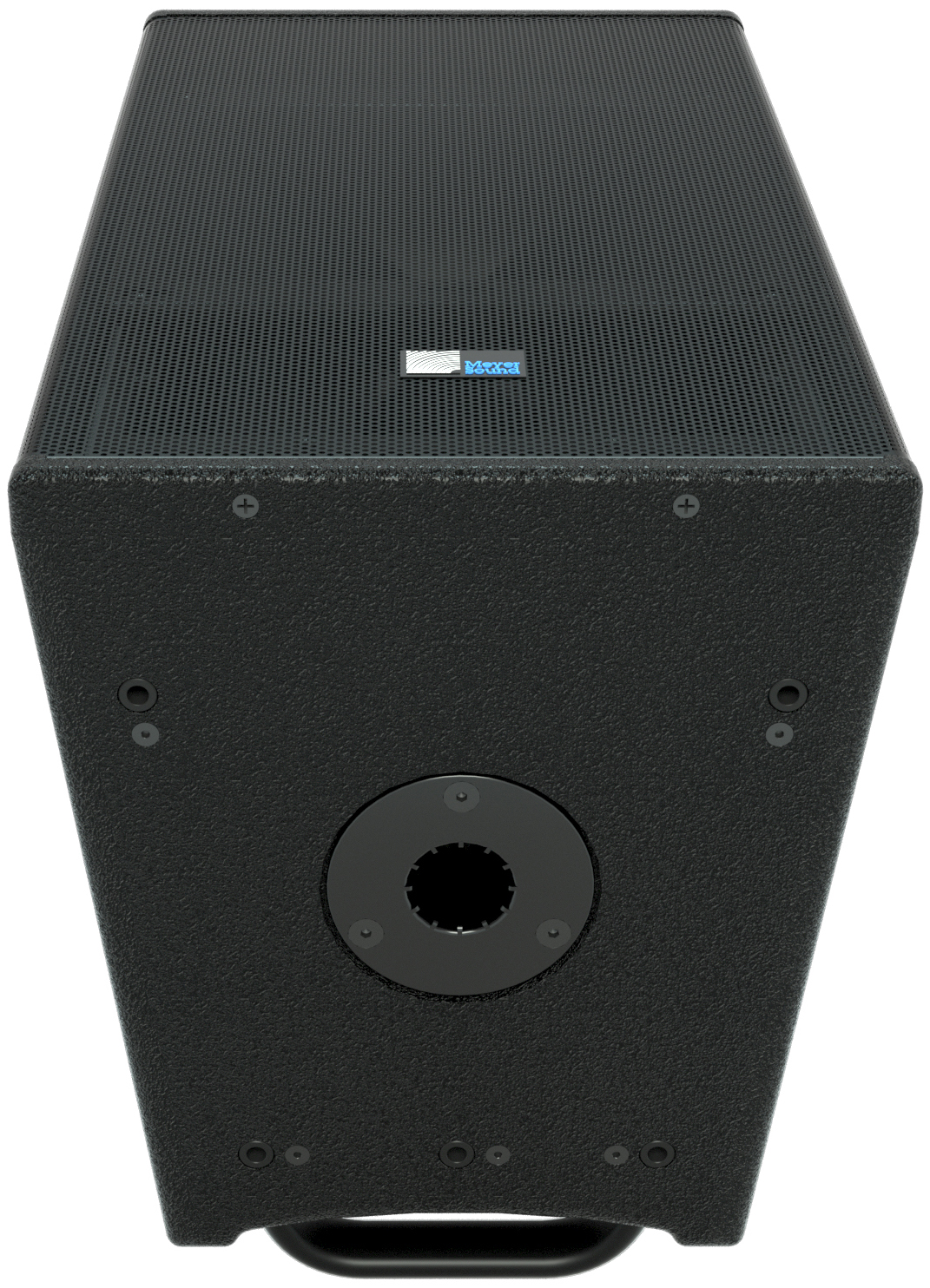
ULTRA-X40 Pole Mount Receptacle

ULTRA-X40 Suspended in an MYA-X40 Yoke Mount

ULTRA-X40 Vertically Held in a MUB-X40 U-Bracket

ULTRA-X40 with an MTC-X40 Top Channel for Pick-Up Point

MTB-X40 Suspending two ULTRA-X40 Vertically Using Two MCP50-x40 Cluster Plates

ULTRA-X40 Horizontally Arrayed Using an MTC-X40 Top Channel and Two MPC50-X40 Cluster Plates
Total System Approach
The ULTRA-X40 loudspeaker integrates seamlessly with other Meyer Sound products. With compatible acoustical and performance characteristics and dedicated QuickFly rigging hardware, the ULTRA-X40/42 loudspeaker and other Meyer Sound self-powered loudspeakers can provide everything needed to design and implement systems for optimum performance in venues of any size or shape.
Tip
Meyer Sound MAPP™ acoustical prediction software allows for quick determination of the coverage, frequency response, impulse response, and maximum linear, undistorted output of Meyer Sound loudspeakers. It also provides useful rigging information.
In addition to smooth integration with other Meyer Sound loudspeakers, the ULTRA-X40/42 loudspeaker can be supplemented with Meyer Sound subwoofers for extended low-frequency bandwidth and headroom. ULTRA-X40/42 systems can be deployed in combination with the 750-LFC very compact low-frequency control element, shown in the first figure below, extending the system frequency response down to 35 Hz, or the 900-LFC compact low-frequency control element, which supports frequencies down to 30 Hz, shown in the second figure below.

The 750-LFC Very Compact Low-Frequency Control Element

The 900-LFC Compact Low-Frequency Control Element
The ULTRA-X40/42 is supported by Meyer Sound’s MAPP acoustical prediction program and the Galileo™ GALAXY Network Platform loudspeaker management system. Once a Meyer Sound system is designed and installed, its performance can be confirmed and optimized using a SIM audio analyzer system.
Power Requirements
The ULTRA-X40/42 loudspeaker combines advanced loudspeaker technology with equally advanced power capabilities. Understanding power distribution, voltage and current requirements, and electrical safety guidelines is critical for the safe operation of the ULTRA-X40/42.
AC Power Distribution
All components in an audio system (self-powered loudspeakers, mixing consoles, and processors) must be properly connected to an AC power distribution system, ensuring that AC line polarity is preserved and that all grounding points are connected to a single node or common point using the same cable gauge (or larger) as the neutral and line cables.
Caution
Make sure the voltage received by the ULTRA-X40/42 loudspeaker remains within its 90–264 V AC operating range. In addition, the ground line must always be used for safety reasons and the line-to-ground voltage should never exceed 250 V AC (typically 120 V AC from line to ground).
Before applying AC power to any Meyer Sound self-powered loudspeaker, make sure that the voltage potential difference between the neutral and earth-ground lines is less than 5 V AC when using single-phase AC wiring.
Note
Improper grounding of connections between loudspeakers and the rest of the audio system may produce noise or hum, or cause serious damage to the input and output stages of the system’s electronic components.
120V AC, 3-Phase Wye System (Single Line) -- Line-Neutral-Earth/Ground
The figure below illustrates a basic 120 V AC, 3-phase Wye distribution system with the loudspeaker load distributed across all three phases, with each loudspeaker connected to a single line and common neutral and earth/ground lines. This system delivers 120 V AC to each loudspeaker.

120 V AC, 3-Phase Wye System (Single Line to Loudspeakers)
120V AC, 3-Phase Wye System (Two Lines) -- Line-Line-Earth/Ground
The figure below illustrates a 120 V AC, 3-phase Wye distribution system with each loudspeaker connected to two lines and a common earth/ground line. This configuration is possible because ULTRA-X40/42 tolerates elevated voltages from the ground line and does not require a neutral line. This system delivers 208 V AC to each loudspeaker.

120 V AC, 3-Phase Wye System (Two Lines to Loudspeakers)
Tip
The 120 V AC, 3-phase Wye system with two lines is recommended because it allows loudspeakers to draw less current than with single-line systems, thereby reducing voltage drop due to cable resistance. It also excludes the potential of varying ground to neutral voltages producing an audible hum.
230V AC, 3-Phase Wye System (Single Line) -- Line-Neutral-Earth/Ground
The figure below illustrates a basic 230 V AC, 3-phase Wye distribution system with the loudspeaker load distributed across all three phases, with each loudspeaker connected to a single line and common neutral and earth/ground lines. This system delivers 230 V AC to each loudspeaker.
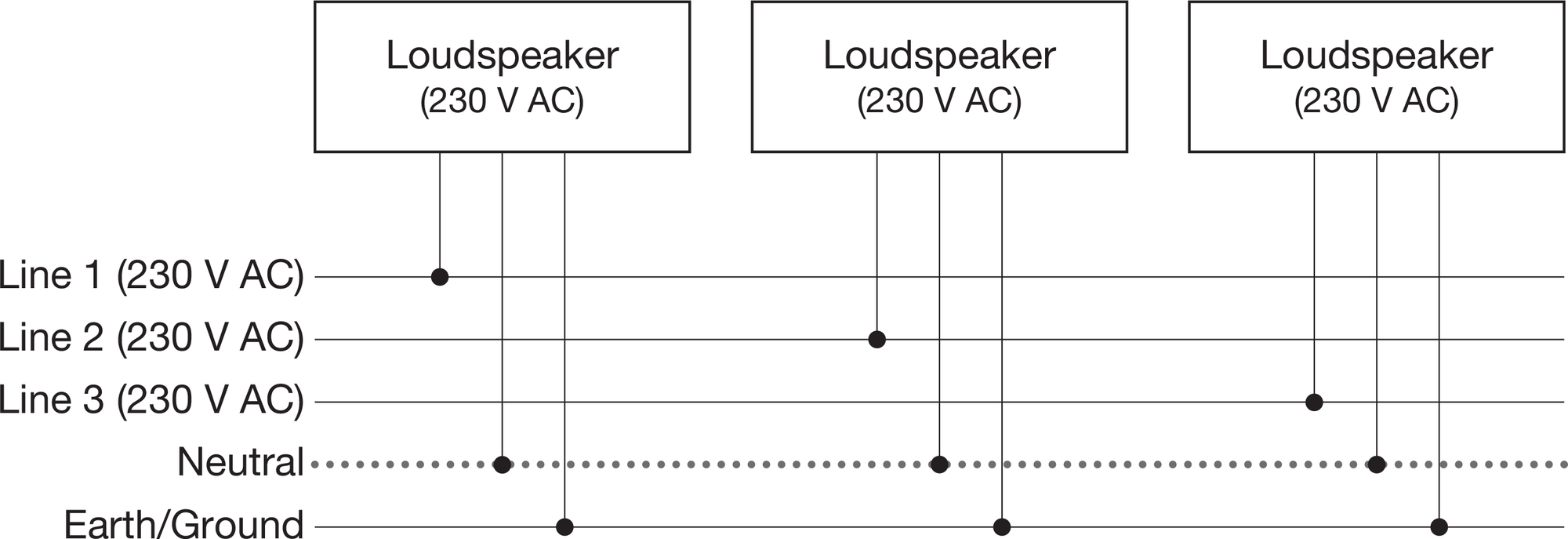
230 V AC, 3-Phase Wye System (Single Line to Loudspeakers)
Caution
For 230 V AC, 3-phase Wye systems, never connect two lines to the AC input of ULTRA-X40/42, as the resulting voltage would exceed the upper voltage limit (275 V AC) and will damage the loudspeaker.
AC CONNECTORS
The ULTRA-X40/42 user panel includes two powerCON 20 connectors one for AC Input (blue) and one for AC Loop Output (gray), as shown in the figure below.

AC Input (Left) and AC Loop Output (Right) Connectors
AC Input (Blue)
The blue AC Input connector supplies power to ULTRA-X40/42. The 3-conductor powerCON 20 is rated at 20 A and uses a locking connector that prevents accidental disconnections. A 10-foot AC power cable, rated at 15 A, is included with each loudspeaker. If the included AC power cable is replaced, make sure to use a cable with the appropriate power plug (on the other end) for the region where the unit will be operated. ULTRA-X40/42 requires a grounded outlet. To operate safely and effectively, it is extremely important that the entire system be properly grounded.
The AC Input connector also supplies power to any additional loudspeakers connected to the loudspeaker’s gray Loop Output connector.
Caution
When looping AC power for loudspeakers, do not exceed the current capability of the AC Input connector (20 A) or the included AC power cable (15 A). Consider the total current draw for all loudspeakers on the circuit, including the first loudspeaker.
AC Loop Output (Gray)
The gray AC Loop Output connector allows multiple ULTRA-X40/42 to be looped and powered from a single power source. The 3-conductor powerCON 20 is rated at 20 A and uses a locking connector that prevents accidental disconnections. For applications that require multiple ULTRA-X40/42, connect the AC Loop Output of the first loudspeaker to the AC Input of the second loudspeaker, and so forth.
The maximum number of loudspeakers that can be looped from the AC Loop Output connector is determined by the voltage of the power source, the current draw of the looped loudspeakers, the circuit breaker rating, and the rating of the AC power cable connected to the first ULTRA-X40/42 loudspeaker, as described in the table below.
Circuit Breaker/ Connector Rating | 115 V AC | 230 V AC | 100 V AC |
|---|---|---|---|
15 A | 6 looped (7 total) | 13 looped (14 total) | 5 looped (6 total) |
20 A | 9 looped (10 total) | 18 looped (19 total) | 8 looped (9 total) |
Note
Current draw for ULTRA-X40/42 is dynamic and fluctuates as operating levels change. The indicated number of loudspeakers that can be looped assumes that operating levels are normal and not such that loudspeakers are constantly limiting.
ULTRA-X40/42 ships with a gray powerCON 20 cable mount connector, rated at 20 A, for assembling AC looping cables. Assembled 1-meter AC looping cables (PN 28.115.032.03) are also available from Meyer Sound.
Wiring AC Power Cables
ULTRA-X40/42 ships with a gray powerCON 20 cable mount connector, rated at 20 A, for assembling AC looping cables, as shown in the figure below. The pins on the powerCON 20 cable mount connector are labeled as follows:
L (Line)
N (Neutral)
PE (Protective Earth or Ground)

powerCON20Cable Mount Connector
How AC power cables are wired is determined by the type of AC power distribution system used (seeAC Power Distribution). When wiring AC power cables for single-line systems, use one of the wiring schemes shown in the figure below and described in the table below:

AC Wiring Scheme
Wire Color | Attach to the Following Terminal | |
|---|---|---|
U.S. / Canada 60Hz | European 50Hz | |
Black | Brown | Hot or live (L) |
White | Blue | Neutral (N) |
Green | Green and Yellow | Protective earth / ground (E or PE) |
Caution
When wiring AC power cables and distribution systems, it is important to preserve AC line polarity and connect the earth ground at both ends of the cable. ULTRA-X40/42 requires a grounded connection. Always use a grounded outlet and plug. It is extremely important that the system be properly grounded to operate safely and properly. Do not ground-lift the AC cable.
Voltage Requirements
ULTRA-X40/42 operates as intended when receiving AC voltage within the following range:
90–264VAC, 50–60Hz
If the voltage drops below 90V, the loudspeaker uses stored power to continue operating temporarily; the loudspeaker powers off if the voltage does not return to its operating range.
If the voltage rises above 275V, the power supply could become damaged.
Caution
The power source for ULTRA-X40/ 42 should always operate within the required operating range, at least a few volts from the upper and lower limits. This approach ensures that AC voltage variations from the service entry—or peak voltage drops due to cable runs—will not cause the loudspeaker’s amplifier to cycle on and off or cause damage to the power supply.
Current Requirements
Current draw for loudspeakers is dynamic and fluctuates as operating levels change. Because different cables and circuit breakers heat up at varying rates, it is important to understand the following types of current ratings and how they affect circuit breaker and cable specifications.
Idle Current — The maximum rms current during idle periods.
Maximum Long-Term Continuous Current — The maximum rms current during a period of at least 10 seconds. The maximum long-term continuous current is used to calculate temperature increases for cables and to ensure that the size and gauge of each cable conforms to electrical code standards. This current rating is also used to select appropriately rated, slow-reacting thermal breakers, which are recommended for loudspeaker power distribution. In addition, the maximum long-term continuous current can be used to calculate the AC looping capability for ULTRA-X40/42 loudspeakers.
Burst Current — The maximum rms current during a period of around 1 second. The burst current is used as a rating for magnetic breakers. It is also used for calculating the peak voltage drop in long AC cable runs according to the following formula:
V pk (drop) = I pk x R (cable total)
Maximum Instantaneous Peak Current — A rating for fast-reacting magnetic breakers.
Use the information in Table 3 to select the appropriate cable gauge and circuit breaker ratings for the system’s operating voltage.
Current Draw | 115V AC | 230V AC | 100V AC |
|---|---|---|---|
Idle | 0.27Arms | 0.25 A rms | 0.29 A rms |
Maximum Long-Term Continuous | 1.9Arms | 1.0 A rms | 2.2 A rms |
Burst | 3.1Arms | 1.5 A rms | 3.4 A rms |
Maximum Instantaneous Peak | 6.9Apeak | 3.4 A peak | 7.9 A peak |
The minimum electrical service amperage required by a loudspeaker system is the sum of the maximum long-term continuous current for all loudspeakers. An additional 30 percent above the combined Maximum Long-Term Continuous amperages is recommended to prevent peak voltage drops at the service entry.
Note
For best performance, the AC cable voltage drop should not exceed 10V (10 percent at 115V and 5percent at 230V). This approach ensures that the AC voltage variations from the service entry— or peak voltage drops due to longer cable runs—do not cause the amplifier to cycle on and off.
Intelligent AC Power Supply
ULTRA-X40/42’s IntelligentAC™ power supply automatically selects the correct operating voltage (allowing the loudspeaker to be used internationally without manually setting voltage switches), eliminates high inrush currents with soft-start power up, suppresses high-voltage transients up to several kilovolts, filters common mode and differential mode radio frequencies (EMI), and sustains operation temporarily during low-voltage periods.
Powering on ULTRA-X40|42
When powering on ULTRA-X40/42, the following startup events take place over several seconds.
Audio output is muted.
Voltage is detected and the power supply mode is automatically adjusted as necessary.
The power supply ramps up.
On the user panel, the On/Status LED flashes multiple colors successively.
The On/Status LED turns solid green, indicating the loudspeaker is unmuted and ready to output audio.
Caution
If the On/Status LED does not turn solid green, or the ULTRA-X40/42 does not output audio after 10 seconds, remove AC power immediately and verify that the voltage is within the required range. If the problem persists, contact Meyer Sound Technical Support.
Electrical Safety Guidelines
Make sure to observe the following important electrical and safety guidelines.
The powerCON 20 connector should not be engaged or disengaged when under load or energized. Either de-energize or disconnect the other end of the cable.]
ULTRA-X40/42 requires a grounded outlet. Always use a grounded outlet and plug.

Do not use a ground-lifting adapter or cut the AC cable ground pin.
Do not exceed the current capability of the 20A AC Input connector for the loudspeaker. When looping loudspeakers, consider the total current draw for all loudspeakers on the circuit, including the first loudspeaker.

Make sure the AC power cable for the loudspeaker has the appropriate power plug (on the other end) for the area in which you will operate the loudspeaker. In addition, the AC power cable must be rated for the total current draw of all loudspeakers looped from the power source.
Do not operate the unit if the power cable is frayed or broken.
Keep all liquids away from ULTRA-X40/42 loudspeakers to avoid hazards from electrical shock.
Amplification and Audio Connectors
The ULTRA-X40/42 drivers are powered by a proprietary 3-channel, open-loop, class D amplifier. The audio signal is processed with electronic crossover, and correction filters for flat phase and frequency responses, and by driver protection circuitry. Each channel has peak and rms limiters that prevent driver over-excursion and regulate voice coil temperatures.
The ULTRA-X40/42 user panel, shown in the figure below, includes Input and Loop output connectors for audio, Limit and Active LEDs, and RMS connectors and controls (see RMS Remote Monitoring System).
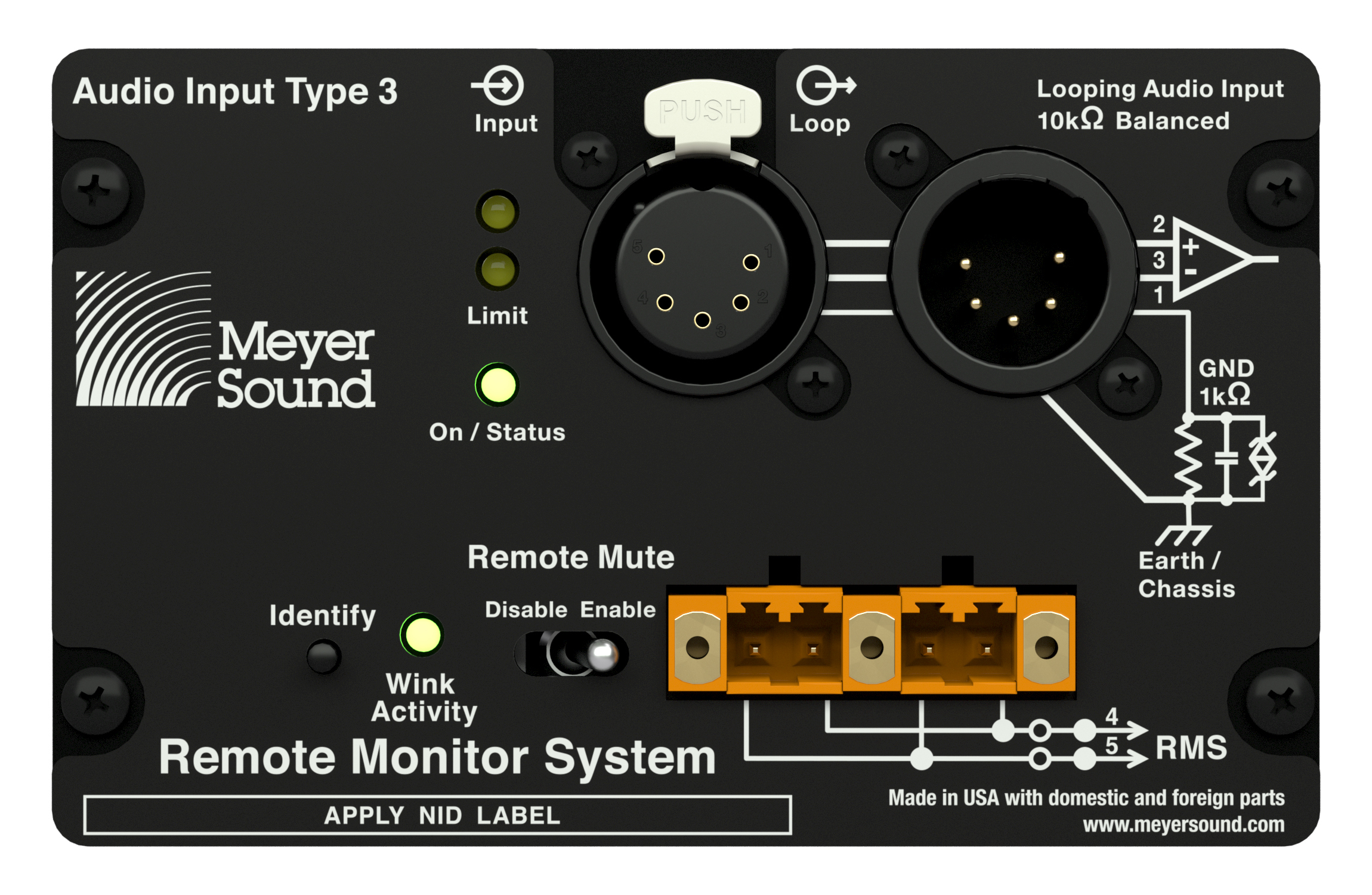
ULTRA-X40/42 User Panel (5-pin XLR and optional RMS)
Audio Connectors
ULTRA-X40/42 is available with XLR 5-pin, as shown in the first figure below, or 3-pin connectors, as shown in the second figure below, for audio Input and audio Loop output. XLR 5-pin connectors accommodate both balanced audio and RMS signals.

XLR 5-Pin Audio Connectors, Input and Loop Output

XLR 3-Pin Audio Connectors, Input and Loop Output
Audio Input (XLR 3-Pin or 5-Pin Female)
The XLR 3-pin or 5-pin female Input connector accepts balanced audio signals with an input impedance of 10 kΩ. The connector uses the following wiring scheme:
Pin 1 — 1 kΩ to chassis and earth ground (ESD clamped)
Pin 2 — Signal (+)
Pin 3 — Signal (–)
Pin 4 — RMS (polarity insensitive)
Pin 5 — RMS (polarity insensitive)
Case — Earth (AC) ground and chassis
Note
Pins 4 and 5 (RMS) are included only with XLR 5-pin connectors.
Pins 2 and 3 carry the input as a differential signal. Pin 1 is connected to earth through a 1 kΩ, 1000 pF, 15 V clamped network. This circuitry provides virtual ground lift for audio frequencies while allowing unwanted signals to bleed to ground. Make sure to use balanced XLR audio cables with pins 1–3 connected on both ends. Telescopic grounding is not recommended and shorting an input connector pin to the case may cause a ground loop, resulting in hum.
Tip
If the loudspeaker produces unwanted noise or hiss, disconnect its input cable. If the noise stops, there is most likely nothing wrong with the loudspeaker. To locate the source of the noise, check the source audio, AC power, and electrical ground.
Audio Loop Output (XLR 3-Pin or 5-Pin Male)
The XLR 3-pin or 5-pin male Loop output connector allows multiple loudspeakers to be looped from a single audio source. The Loop output connector uses the same wiring scheme as the Input connector (see Audio Input (XLR 3-Pin or 5-Pin Female). For applications that require multiple ULTRA-X40/42, connect the Loop output of the first loudspeaker to the Input of the second loudspeaker, and so forth.
Note
The Loop output connector is wired in parallel to the Input connector and transmits the unbuffered source signal even when the loudspeaker is powered off.
Calculating Load Impedance for Looped Audio Signals
To avoid distortion when looping multiple loudspeakers, make sure the source device can drive the total load impedance of the looped loudspeakers. In addition, the source device must be capable of delivering approximately 20 dBV (10 V rms into 600 Ω) to yield the maximum SPL over the operating bandwidth of the loudspeakers.
To calculate the load impedance for the looped loudspeakers, divide 10 kΩ (the input impedance for a single loudspeaker) by the number of looped loudspeakers. For example, the load impedance for 10 ULTRA-X40/42 is 1000 Ω (10 kΩ/ 10). To drive this number of looped loudspeakers, the source device should have an output impedance of 100 Ω or less. This same rule applies when looping ULTRA-X40/42 with other Meyer Sound self-powered loudspeakers.
Note
Most source devices are capable of driving loads no less than 10 times their output impedance.
Tip
Audio outputs from Meyer Sound’s loudspeaker GALAXY Network Platform have an output impedance of 50 ohms. Each output can drive up to 20 Meyer Sound (10 kΩ) loudspeakers without distortion.
Caution
Make sure that all cabling for looped loudspeakers is wired correctly (Pin 1 to Pin 1, Pin 2 to Pin 2, and so forth) to prevent the polarity from being reversed. If one or more loudspeakers in a system have reversed polarity, frequency response and coverage will be significantly degraded.
TruPower Limiting
The ULTRA-X40/42 employs Meyer Sound’s advanced TruPower® limiting. Conventional limiters assume a constant driver impedance and set the limiting threshold by measuring voltage alone. This method is inaccurate, because driver impedances change as frequency content in the source material changes, and as thermal values for the loudspeaker’s voice coil and magnet vary. Consequently, conventional limiters often begin limiting prematurely, which reduces system headroom and dynamic range.
In contrast, TruPower limiting anticipates varying driver impedances by measuring both current and voltage to compute the actual power dissipation in the voice coil. This approach improves performance, both before and during limiting, by allowing the driver to produce the maximum SPL across its entire frequency range, while also retaining signal peaks. TruPower limiting also eliminates power compression at high levels over lengthy periods, which helps regulate voice coil temperatures, thereby extending the life of the driver.
HF and LF Limit LEDs
The low- and high-frequency drivers for ULTRA-X40/42 are powered by separate amplifier channels, each with their own limiter. Limiting activity is indicated with two Limit LEDs on the user panel. The top Limit LED, shown in the figure below, indicates limiting for the high-frequency channel and the bottom Limit LED indicates limiting for the low-frequency channel.
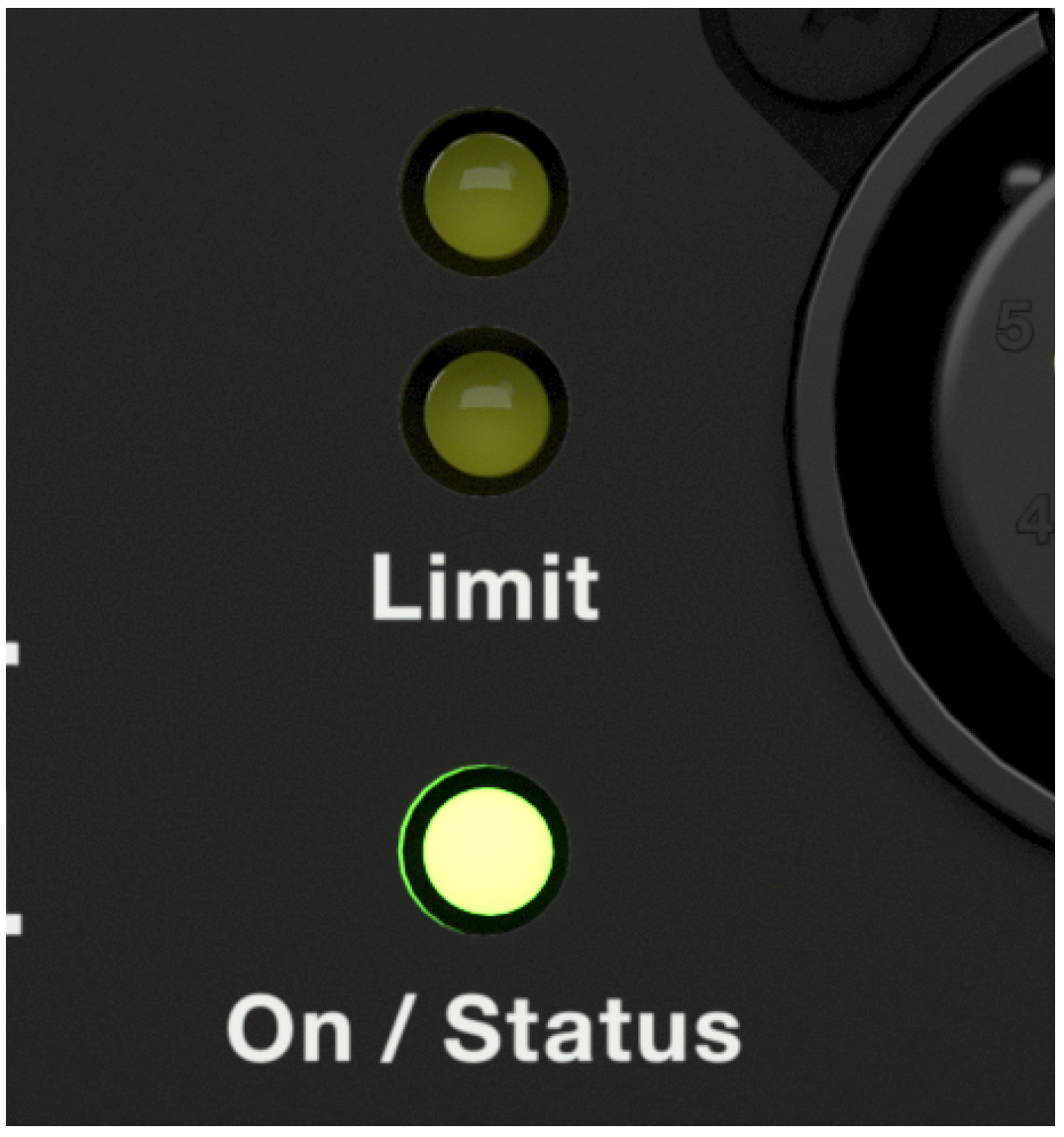
ULTRA-X40/42 Limit LEDs
When engaged, the limiters not only protect the drivers but also prevent signal peaks from causing excessive distortion in the amplifier channels, thereby preserving headroom and maintaining smooth frequency response at high levels.
When levels return to normal, below the limiter thresholds, limiting ceases.
ULTRA-X40/42 performs within its acoustical specifications at normal temperatures when the Limit LEDs are unlit, or when the LEDs are lit for 2 seconds or less and then turn off for at least 1 second. If the LEDs remain lit for longer than
3 seconds, the loudspeaker enters hard limiting where:
Increases to the input level have no effect
Distortion increases due to clipping
Drivers are subjected to excessive heat and excursion, thereby compromising their lifespan
Caution
The Limit LEDs indicate when a safe, optimum level is exceeded. If an ULTRA- X40/42 loudspeaker system begins to limit before reaching the desired SPL, consider adding more units to the system.
AMPLIFIER COOLING SYSTEM
The ULTRA-X40/42 loudspeaker is convection cooled. The amplifier’s heat sink provides natural convection cooling from the air flowing near its fins.
Caution
To keep ULTRA-X40/42 from overheating, allow at least 3 in behind the loudspeaker for proper ventilation.
The ULTRA-X40/42 heat sink can reach temperatures up to 80° C (176° F) during extreme operation. Wait 15 minutes for the unit to cool before touching.
ON/STATUS LED
During normal operation, when ULTRA-X40/42 is powered on, the On/Status LED is solid green. If the loudspeaker encounters a hardware fault, or the unit begins to overheat, the LED flashes red. In some instances, the loudspeaker will continue to output audio while the LED flashes red, though with a reduction in the limiter threshold and acoustic output to protect the loudspeaker.
If a loudspeaker is overheating (for RMS-equipped loudspeakers, you can verify this situation in Compass RMS), a reduction in SPL may be necessary. If after a reduction in SPL and an appropriate cooling period the On/ Status LED continues to flash red (does not return to solid green), contact Meyer Sound Technical Support.
If the On/Status LED flashes red and the loudspeaker does not output audio, contact Meyer Sound Technical Support immediately.
Caution
If an ULTRA-X40/42 loudspeaker system consistently overheats before reaching the desired SPL, consider adding more units to the system.
Note
During startup, the On/Status LED flashes multiple colors successively. For more information about the power on sequence, see “Intelligent AC Power Supply” on page 18.
Tip
When an ULTRA-X40/42 is connected to an RMS network, the Compass RMS software provides additional feedback about the loudspeaker’s hardware status and operating temperature. For more information, see [→ _bookmark99]Chapter 6, [→ _bookmark99]“RMS Remote Monitoring System.”
An ULTRA-X40/42 loudspeaker system can be deployed with Meyer Sound self-powered low frequency control elements (see [→ _bookmark46]Table 4). These subwoofers achieve very low frequency responses and extend the system response appreciably, increasing the overall acoustic power of the system in the lowest frequencies.
The ideal ratio of ULTRA-X40/42 loudspeakers to low frequency control element depends on the following variables:
Subwoofer model
System configuration
Frequency content of source material
Headroom required for low frequencies
For most applications, the ratios in the table below should yield good results.
Subwoofer | Frequency Response | Recommended Ratio (Number of ULTRA-X40/42s per Subwoofer) |
|---|---|---|
USW-210P | 32–123 Hz ±4 dB | 1:1 for most applications 1:2 for applications requiring more low end |
750-LFC | 37–110 Hz ±4 dB | 1:1 for most applications |
900-LFC | 32–115 Hz ±4 dB | 2:1 for most applications 1:1 for applications requiring extreme low end |
1100-LFC | 30–85 Hz ±4 dB | 4:1 for most applications |
ADDING SUBWOOFERS BY DAISY-CHAINING
Full-range signals can be connected directly to
Meyer Sound self-powered loudspeakers because the loudspeakers have built-in active crossovers. Subwoofers can be added to an ULTRA-X40/42 system by simply daisy-chaining them to the ULTRA-X40/42 loudspeakers.
To daisy-chain the suggested number of ULTRA-X40/42 loudspeakers for your subwoofer (see Table 1).
Connect the source signal to the Input of the first ULTRA-X40/42, then connect the Loop output of the first ULTRA-X40/42 to the Input of the second ULTRA-X40/42 (and so forth).
Connect the Loop output of the last ULTRA-X40/42 in the chain to the subwoofer Input.
When ULTRA-X40/42 loudspeakers are coplanar, or they are very close together, about four to six feet like in the case of pole mounting, the phase response will work well in the area of interaction and the result will be a fairly flat frequency response. However, the response will show an increase in the 60–200 Hz range where the response of the loudspeakers overlaps.
Note
If the subwoofer’s Limit LEDs begin to light before reaching the required SPL, consider adding more subwoofers to meet the SPL requirements without exposing the drivers to excessive heat and excursion.
USING A PROCESSOR
In larger systems when individual control for the
ULTRA-X40/42 and subwoofers are needed or desired, if the ULTRA-X40/42 loudspeakers and subwoofer are more than six feet apart, or if a delay is required between them, use a measurement system like Meyer Sound’s SIM to determine appropriate delay and polarity settings.
Caution
Make sure the source signal is sufficient to drive the total load impedance of the daisy-chained loudspeakers (see Calculating Load Impedance for Looped Audio Signals).
Tip
MAPP can be used to accurately predict the appropriate loudspeaker deployment and subwoofer integration for loudspeaker systems, complete with coverage data, system delay and equalization settings, rigging information, and detailed design illustrations. For more information, see MAPP System Design Tool.
Amplifier Cooling System
The ULTRA-X40/42 loudspeaker is convection cooled. The amplifier’s heat sink provides natural convection cooling from the air flowing near its fins.
Caution
To keep ULTRA-X40/42 from overheating, allow at least 3 in behind the loudspeaker for proper ventilation.
The ULTRA-X40/42 heat sink can reach temperatures up to 80° C (176° F) during extreme operation. Wait 15 minutes for the unit to cool before touching it.
On/Status LED
During normal operation, when ULTRA-X40/42 is powered on, the On/Status LED is solid green. If the loudspeaker encounters a hardware fault, or the unit begins to overheat, the LED flashes red. In some instances, the loudspeaker will continue to output audio while the LED flashes red, though with a reduction in the limiter threshold and acoustic output to protect the loudspeaker.
If a loudspeaker is overheating (for RMS-equipped loudspeakers, you can verify this situation in Compass RMS), a reduction in SPL may be necessary. If after a reduction in SPL and an appropriate cooling period the On/ Status LED continues to flash red (does not return to solid green), contact Meyer Sound Technical Support.
If the On/Status LED flashes red and the loudspeaker does not output audio, contact Meyer Sound Technical Support immediately.
Caution
If an ULTRA-X40/42 loudspeaker system consistently overheats before reaching the desired SPL, consider adding more units to the system.
Note
During startup, the On/Status LED flashes multiple colors successively. For more information about the power on sequence, see “Intelligent AC Power Supply” on page 18.
Tip
When an ULTRA-X40/42 is connected to an RMS network, the Compass RMS software provides additional feedback about the loudspeaker’s hardware status and operating temperature. For more information, see [→ _bookmark99]Chapter 6, [→ _bookmark99]“RMS Remote Monitoring System.”
Adding Low-frequency Control
An ULTRA-X40/42 loudspeaker system can be deployed with Meyer Sound self-powered low-frequency control elements (see [→ _bookmark46]Table 4). These subwoofers achieve very low-frequency responses and extend the system response appreciably, increasing the overall acoustic power of the system in the lowest frequencies.
The ideal ratio of ULTRA-X40/42 loudspeakers to low-frequency control element depends on the following variables:
Subwoofer model
System configuration
Frequency content of source material
Headroom required for low frequencies
For most applications, the ratios in the table below should yield good results.
Subwoofer | Frequency Response | Recommended Ratio (Number of ULTRA-X40/42s per Subwoofer) |
|---|---|---|
USW-210P | 32–123 Hz ±4 dB | 1:1 for most applications 1:2 for applications requiring more low end |
750-LFC | 37–110 Hz ±4 dB | 1:1 for most applications |
900-LFC | 32–115 Hz ±4 dB | 2:1 for most applications 1:1 for applications requiring extreme low end |
1100-LFC | 30–85 Hz ±4 dB | 4:1 for most applications |
Adding Subwoofers by Daisy-chaining
Full-range signals can be connected directly to
Meyer Sound self-powered loudspeakers because the loudspeakers have built-in active crossovers. Subwoofers can be added to an ULTRA-X40/42 system by simply daisy-chaining them to the ULTRA-X40/42 loudspeakers.
To daisy-chain the suggested number of ULTRA-X40/42 loudspeakers for your subwoofer (see Table 1).
Connect the source signal to the Input of the first ULTRA-X40/42, then connect the Loop output of the first ULTRA-X40/42 to the Input of the second ULTRA-X40/42 (and so forth).
Connect the Loop output of the last ULTRA-X40/42 in the chain to the subwoofer Input.
When ULTRA-X40/42 loudspeakers are coplanar, or they are very close together, about four to six feet like in the case of pole mounting, the phase response will work well in the area of interaction and the result will be a fairly flat frequency response. However, the response will show an increase in the 60–200 Hz range where the response of the loudspeakers overlaps.
Note
If the subwoofer’s Limit LEDs begin to light before reaching the required SPL, consider adding more subwoofers to meet the SPL requirements without exposing the drivers to excessive heat and excursion.
Using a Processor
In larger systems when individual control for theULTRA-X40/42 and subwoofers are needed or desired, if the ULTRA-X40/42 loudspeakers and subwoofer are more than six feet apart, or if a delay is required between them, use a measurement system like Meyer Sound’s SIM to determine appropriate delay and polarity settings.
Caution
Make sure the source signal is sufficient to drive the total load impedance of the daisy-chained loudspeakers (see Calculating Load Impedance for Looped Audio Signals).
Tip
MAPP can be used to accurately predict the appropriate loudspeaker deployment and subwoofer integration for loudspeaker systems, complete with coverage data, system delay and equalization settings, rigging information, and detailed design illustrations. For more information, see MAPP System Design Tool.
QuickFly Rigging
The ULTRA-X40 and ULTRA-X42 loudspeakers are compatible with Meyer Sound’s QuickFly system, a comprehensive collection of custom-designed rigging, flying, and mounting options. Comprised of rugged, reliable, and easy-to-configure components, QuickFly lets you deploy ULTRA-X40 and ULTRA-X42 loudspeakers as either individual loudspeakers or as arrays at precise angles to take full advantage of their directional components.
Important Safety Considerations
When installing Meyer Sound loudspeakers and subwoofers, the following precautions should always be observed:
All Meyer Sound products must be used in accordance with local, state, federal, and industry regulations. It is the owner’s and user’s responsibility to evaluate the reliability of any rigging method for their application. Rigging should only be carried out by experienced professionals.
Use mounting and rigging hardware that has been rated to meet or exceed the weight being hung.
Make sure to attach mounting hardware to the building’s structural components (roof truss), and not just to the wall surface.
Make sure bolts and eyebolts are tightened securely. Meyer Sound recommends using Loctite® on all threaded fasteners.
Inspect mounting and rigging hardware regularly. Immediately replace any worn or damaged components.
Rigging Points
The top and bottom faces for the ULTRA-X40/42 cabinet include high-strength, corrosion-resistant stainless steel points that provide M8 x 1.25 threaded holes for easy connection to QuickFly rigging and third-party mounting options.

ULTRA-X40/42 Rigging Points
ULTRA-X40/42 Rigging Option Accessories
Meyer Sound offers many rigging options, as listed in the table below, that facilitate a wide variety of configurations.
Model | Features |
|---|---|
MPK-POLE-35MM-M20 Adjustable Pole Mount Kit (PN 40.010.973.01) | Adjustable length 927–1524 mm (36.5–60 in) pole with assisted lift. Lower shaft fits 35 mm cups or use the removable M20 threaded lug for added stability. Upper shaft includes a PAS-M20 Adapter Sleeve to fit loudspeakers with 35 mm and M20 internal pole mounts onto a 35 mm speaker stand. (Can also buy the PAS-M20 Adapter Sleeve separately). Additional 35 mm to 38 mm (1.5 in) adapter included. |
PAS-M20-35MM Adapter Sleeve (PN.40.010.974.01) | Adapts a 35 mm pole to a 35 mm M20 threaded connection to provide additional stability when using 35 mm M20 pole cups. |
MYA-X40 Mounting Yoke Kit (PN 40.287.039.01) | The MYA-X40 Yoke suspends a single ULTRA-X40/42 loudspeaker and supports a wide range of horizontal and vertical adjustments. The yoke attaches to the top of the loudspeaker using three rig nuts. The kit includes three M8 bolts and three M8 knobs. The yoke may also be mounted on a 35 mm pole using the optional MSA-STAND Adapter Cup 35MM accessory to facilitate easy panning and tilting. |
MSA-STAND Adapter Cup 35MM (PN 40.086.013.01) | This compact cup-type adapter can be used to mount the MYA-X40 Mounting Yoke on a pole to allow for easy panning and tilting of the ULTRA-X40/42. |
MUB-X40 U-Bracket Kit (PN 40.287.055.01) | The MUB-X40 U-Bracket allows a single ULTRA-X40/42 loudspeaker to be mounted to a wall (in either vertical or horizontal orientations), to the ceiling or onto the floor. The kit includes two M8 bolts, two M8 knobs, and a 35 mm diameter, Thread Reducer M20 to M8 (35 MM) to convert the cabinet's built-in pole mount internal threads to M8 size. The MUB-X40 U-Bracket can also mount an ULTRA-X40/42 to a pole in the horizontal orientation using the 35MM Pole Stand Adapter. |
35MM Pole Stand Adapter (PN 40.010.971.01) | This large base stand adapter can be used to mount the MTB-X40 Top Bracket or the MUB-X40 U-bracket onto a pole. |
MTC-X40 Top Channel Kit (PN 40.287.130.01) | The MTC-X40 Top Channel kit includes a pinnable link in a channel that mounts directly to the top of the ULTRA-X40/42 rig nuts or into an MCP50-X40 or MCP70-X40 plate and supports pick-up of up to three ULTRA-X40/42 loudspeakers from a single point using the two included lock pins and 3/ 8 in shackle. Using the MTC-X40 Top Channel at the bottom of the ULTRA-X40/42 to pick up multi- ple loudspeakers requires the use of a Thread Reducer M20 to M8 (35MM), which is not included. |
MCP50-X40 Cluster Plate Kit (PN 40.287.100.01) | The MCP50-X40 50 Degree Cluster Plate kit includes two cluster plates to facilitate installation of ULTRA-X40/42 loudspeakers in both horizontal and vertical clusters at angles between 10 and 50 degrees in 5 degree increments. The kit includes eight M8 bolts and eight M8 knobs. The MTC-X40 Top Channel accessory (sold separately) can be attached to the MCP50-X40 as a top pick up point. |
MCP70-X40 Cluster Plate Kit (PN 40.287.400.01) | The MCP70-X40 70 Degree Cluster Plate kit includes two cluster plates to facilitate installation of ULTRA-X40/42 loudspeakers in both horizontal and vertical clusters at angles between 40 and 70 degrees in 5 degree increments. The kit includes eight M8 bolts and eight M8 knobs. The MTC-X40 Top Channel accessory (sold separately) can be attached to the MCP70-X40 as a top pick up point. |
MTB-X40 Top Bracket Kit (PN 40.287.150.01) | The MTB-X40 Top Bracket kit includes a heavy-duty, U-bracket style accessory that facilitates mounting of ULTRA-X40/42 loudspeakers from the ceiling or a truss using the cluster plates. The design supports 5–25 degrees of downtilt and 5 degrees of uptilt. In addition, the MTB-X40 Top Bracket enables mounting of a single ULTRA-X40/42 onto the floor for front-fills. The kit includes four M8 bolts and four M8 knobs. The MTB-X40 Top Bracket can also mount an ULTRA-X40/42 to a pole in the horizontal orientation using the 35MM Pole Stand Adapter. |
Thread Reducer M20 to M8 (35MM) (PN 40.010.540.01) | The Thread Reducer kit includes a 35 mm diameter, M20 to M8 thread size adapter to convert the cabinet's built-in pole mount internal threads to M8 size. It is necessary for installing the MUB-X40 U-Bracket (one included in MUB-X40 U-Bracket kit) and when installing the MTC-X40 Top Channel or eye bolts at the bottom of a cabinet (not included in the eye bolts or MTC-X40 Top Channel kits). |
3/8 in Shackle, Black (PN 124.145) | Replacement 3/8 in Black Shackle |
eye bolts (PN 40.287.057.01) | Replacement black-coated M8 x 13 mm eye bolts, quantity 2 . |
0.25 in x 0.90 in Lock Pin with washer (PN 45.010.936.01) | Replacement 0.25 in x 0.90 in Lock Pin with washer. |
M8 Knob and Washer Assembly (PN 45.287.061.01) | Replacement M8 Knob and Washer Assembly |
M8 Hex Head Screw with Washer (PN 45.287.461.01) | Replacement M8 Hex Head Screw with Washer, M8x17 mm, stainless steel, black |
Rotating the Horn
The ULTRA-X40/42 may be rotated for increased installation flexibility. However, care must be taken so as to not damage the loudspeaker.
Note
In the paragraphs below, instructions and graphics for the ULTRA-X40 are used. The same procedure holds for the ULTRA-X42 (with 110° replaced by 70°).
Remove the grille by removing the four 10-32 x 1.00-inch flat-head Phillips screws (two on the top and two on the bottom) of the loudspeaker grille.

Remove ULTRA-X4x Grille Frame
Remove the four truss-head Phillips 10-32 x 3/4-inch screws holding the horn in place.

Removing Four Screws Holding the Horn in Place
Determine the present orientation of the horn by checking the horn throat orientation when the speaker is vertical with the port at the bottom. The cabinet is vertical when the Meyer Sound Logo on the horn and on the bezel are at the top.
If the present orientation is 110° horizontal by 50° vertical (horn throat is vertical, the horn may only be rotated in the clockwise direction.
Caution
Do not pull the horn out to rotate and do not use force. It should rotate smoothly if rotated in the correct direction. The rotation angle is NOT continuous. It is limited to 90° of travel between the two orientations where the Meyer Sound emboss on the bezel lines up with either the company logo or the engraved company name on the horn.

110° horizontal by 50° vertical horn orientation

Clockwise Rotation of Horn to achieve 50° horizontal by 110° vertical horn orientation -90° rotation direction
If the present orientation is 50° horizontal by 110° vertical horn throat is horizontal, the horn may only be rotated in the counter-clockwise direction.
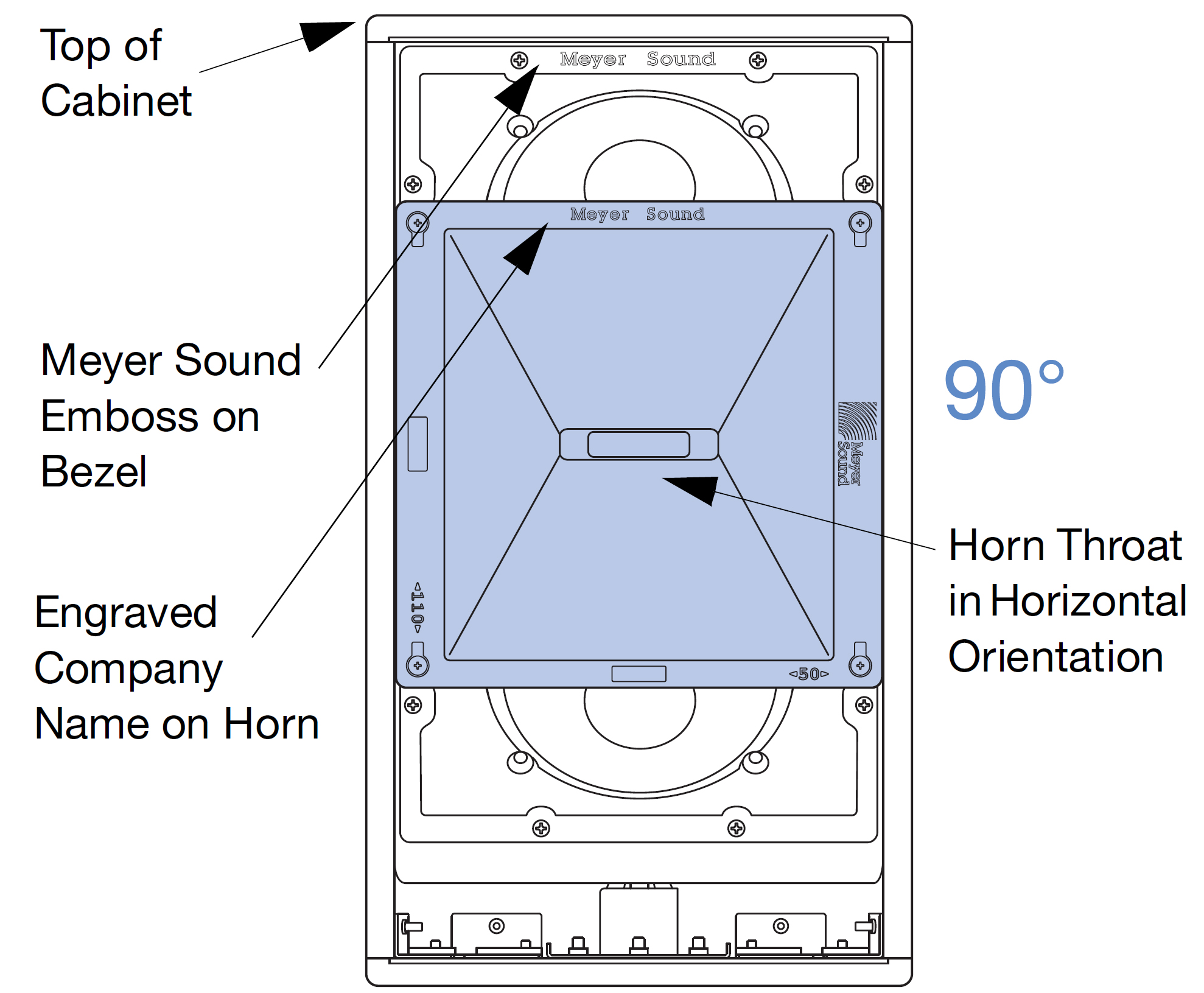
110° horizontal by 50° vertical horn orientation

Counter-clockwise Rotation of Horn to achieve 110° horizontal by 50° vertical horn orientation
Replace the four screws removed in Step 2 to resecure the horn into position. Be sure to use the 10-32 x 3/4-inch screws. The recommended torque value for the horn screws is 19 in-lb (2.15 N·m).
Replace the grille and secure it with the four 10-32 x 1.00-inch screws removed in step 1. Meyer Sound recommends applying blue thread locker (medium strength) to screws in the leading three threads before replacing them. The recommended torque value for the grille screws is 8 in-lb (0.90 N·m).
Basic Eye Bolt Rigging
The ULTRA-X40 loudspeaker can be suspended simply using M8 eye bolts. A minimum of two eye bolts are required when suspending a single loudspeaker. The use of two eye bolts provides the added flexibility of aiming and tilting the loudspeaker for targeted coverage. Meyer Sound offers a kit with 2 black-coated M8 x 13 mm eye bolts (PN 40.287.057.01).
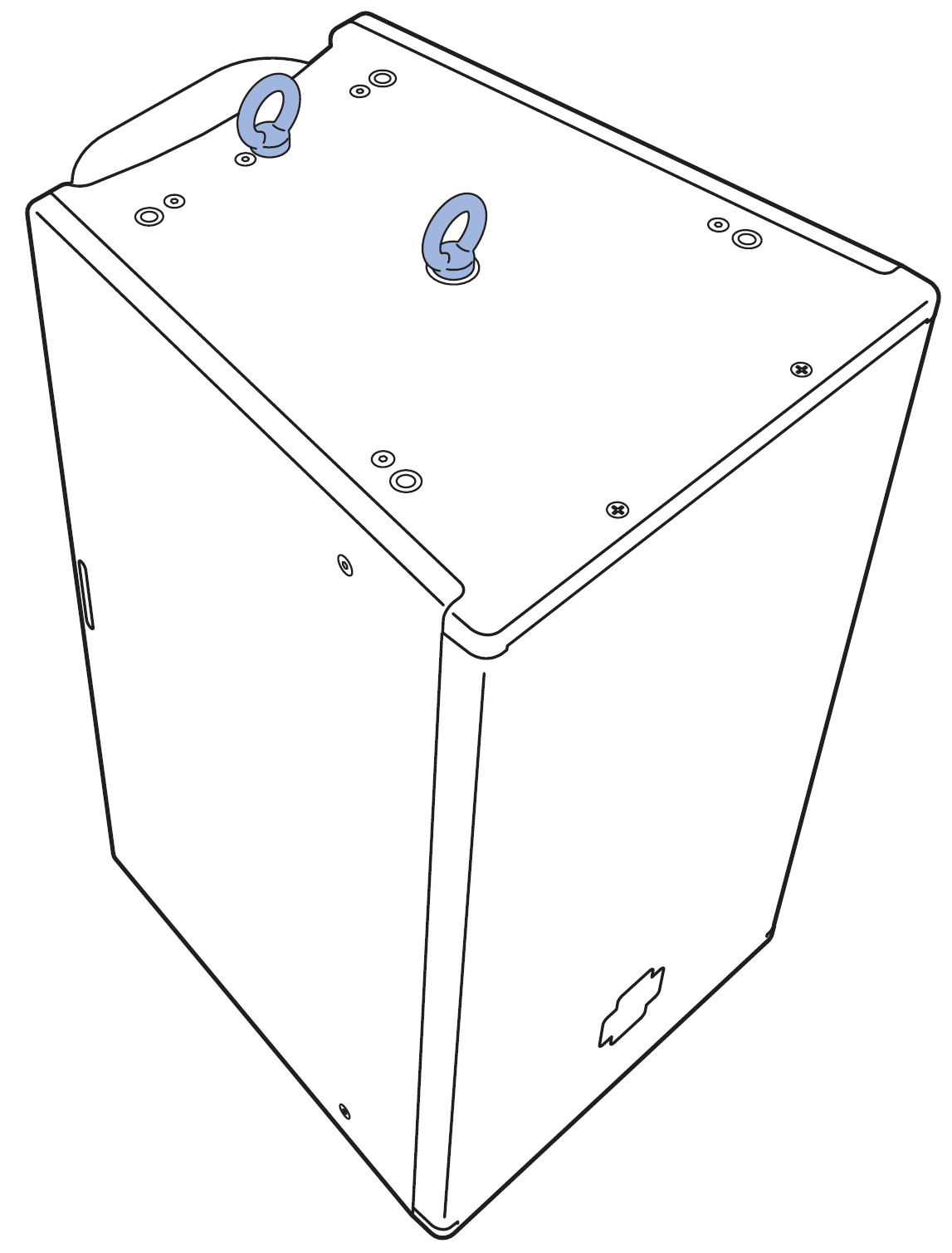
ULTRA-X40 with Two Eye Bolts
Note
Up to two ULTRA-X40 loudspeakers, oriented vertically, can be suspended with Meyer Sound eye bolts at a 5:1 safety factor. For this configuration, the top loudspeaker would have two eye bolts installed on its top and two eye bolts installed on its bottom (for connecting to the second loudspeaker), and the bottom of the upper loudspeaker requires the optional Thread Reducer M20 to M8 35MM accessory (PN 40.010.540.01).
Pole-mounting the ULTRA-X40
The MPK-POLE-35MM-M20 (PN 40.010.973.01) provides an easy and efficient way to mount the ULTRA-X40/42 on top of a 750-LFC (or 900-LFC). The MPK-POLE-35MM-M20 features all steel shafts that telescope from 36.5–60 inches and employs a secure knob to hold it in a specific position. The upper shaft includes the removable PAS-M20 Adapter Sleeve that fits the ULTRA-X40/42 internal 35 mm and M20 pole mount receptacle to make this connection more robust.
Meyer Sound offers the PAS-M20-35MM with M20 slug adapter sleeve separately (PN 40.010.974.01) for use with third-party 35 mm poles.

MPK-POLE-35MM-M20 kit
The MPK-POLE features a lift assist that provides approximately 40 lb of internal gas cylinder pneumatic lift. The lower end of the pole is 35 mm in diameter and has an M20 threaded lug for stability that can be removed if necessary. In addition, the MPK-POLE-35MM-M20 kit includes an adapter for converting the bottom diameter from 35 mm to 38 mm.
Locate the set screws on the Removable M20 Slug side of the pole.
Loosen the set screws using a 2.5 mm hex wrench. Do not loosen so far that the screws fall out of the pole and are lost.
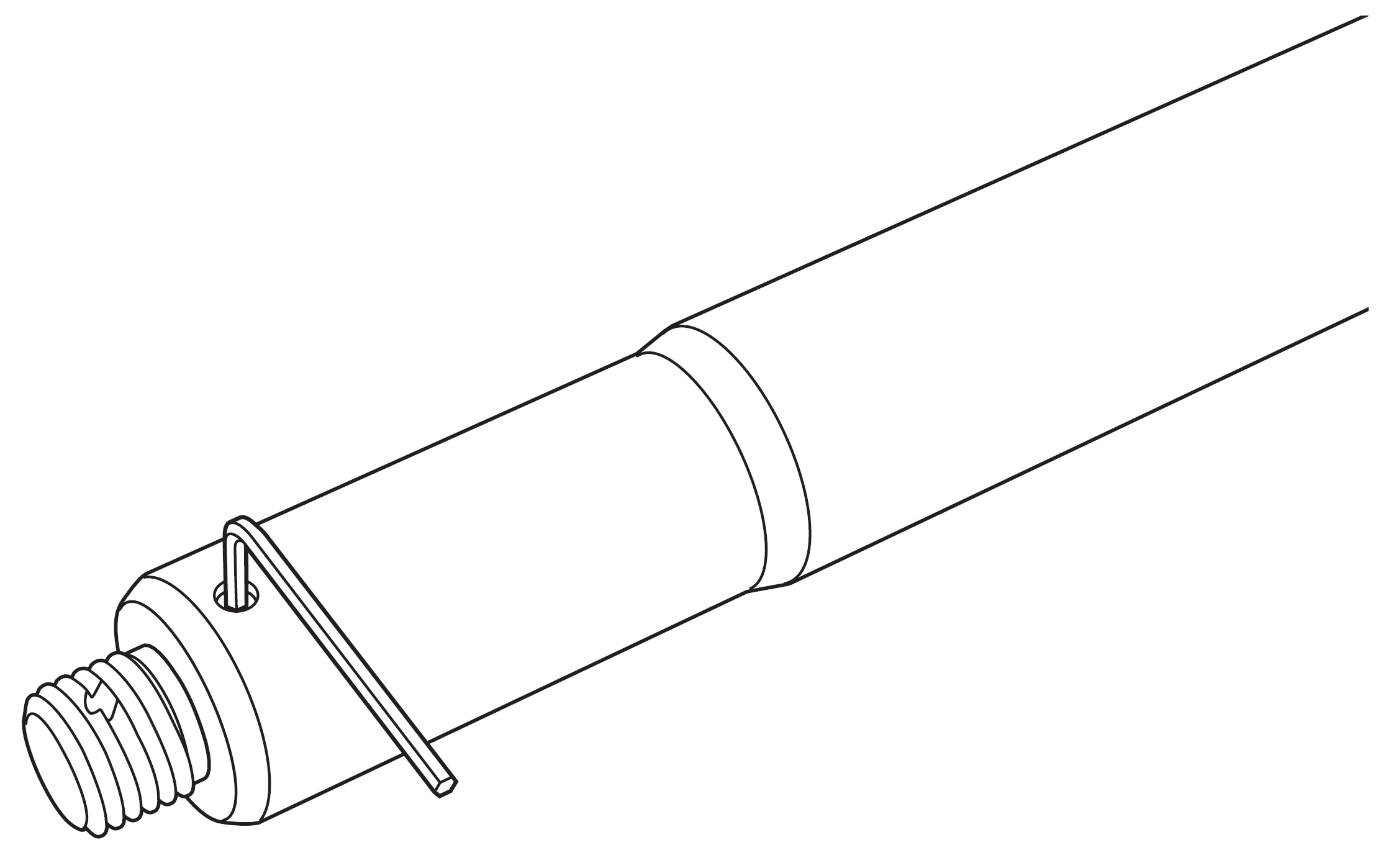
Using Hex Wrench to Loosen M20 Slug Set Screws
Loosen the M20 lug by rotating counter-clockwise (inserting a screwdriver through the lug can help with this process) and remove it.

Inserting Screwdriver to Remove M20 Lug
Tighten the set screws enough to ensure they will remain in the pole.

Pole with M20 Slug Removed
The pole can be used without the lug for loudspeakers that have 35 mm cup mounts without M20 threads, or the 35 mm to 38 mm adapter may be slipped onto the bottom for loudspeakers that have 38 mm cups.

Pole with 35 mm to 38 mm Adapter Sleeve Attached
Meyer Sound recommends that a 750-LFC (or 900-LFC) be upgraded with the 35 mm/M20 internal pole mount cup (PN 40.271.016.02) for a more stable connection. This part is included with the MPK-POLE kit.

35 mm/M20 Internal Pole Mount Cup (PN 40.271.016.02)
The PAS-M20-35MM Adapter is designed to securely fit into the M20 thread of the ULTRA-X4x integral pole mount. The separate knob on the adapter tightens it to the pole. (It can also be secured onto any other standard 35 mm pole.)
Tip
Use the PAS-M20-35MM knob to secure the adapter to a pole when packing the pole for travel.
The PAS-M20-35MM may be independently (apart from the pole) threaded into the ULTRA-X4x, and then the loudspeaker/PAS-M20-35MM Adapter combination mounted onto a pole that is already secured in the subwoofer. The loudspeaker may be aimed horizontally, and the PAS-M20-35MM knob tightened.

Inserting the PAS-M20-35MM Adapter Independently

Settling Loudspeaker/Adapter Combination onto Pole
Alternatively, the PAS-M20-35MM Adapter can be secured to the pole first and then the two items jointly inserted into the subwoofer mounting cup and tightened. The loudspeaker may then be lifted onto the PAS-M-20-35MM adapter and rotated until the M20 thread is tightened within the loudspeaker’s mounting cup. Loosening the PAS-M20-35MM Adapter knob after the loudspeaker/ PAS-M20-35MM Adapter M8 connection is secure can again facilitate horizontal aiming of the loudspeaker.

Rotating Loudspeaker onto PAS-M20-35MM
Note
The ULTRA-X40/42 integral pole mount adapter will receive any 35mm pole shaft. However, the use of the Meyer Sound MPK-Pole-35MM-M20 and the PAS-M20-35MM is recommended to make a more robust connection.
When using a third-party pole, make sure the pole is designed to support the total weight of the ULTRA-X40/42 loudspeaker and observe all safety precautions specified by the pole manufacturer.
MYA-X40 Mounting Yoke
The MYA-X40 mounting yoke (PN 40.287.039.01) suspends a single ULTRA-X40/42 loudspeaker and supports a wide range of horizontal and vertical adjustments. The yoke attaches to the top of the loudspeaker using three of the six rig nuts. The kit includes three M8 bolts and three M8 knobs. The bolts are recommended for fixed installations. A hanging clamp and steel safety cable (not included) are required to suspend the MYA-X40 mounting yoke.

MYA-X40 Mounting Yoke
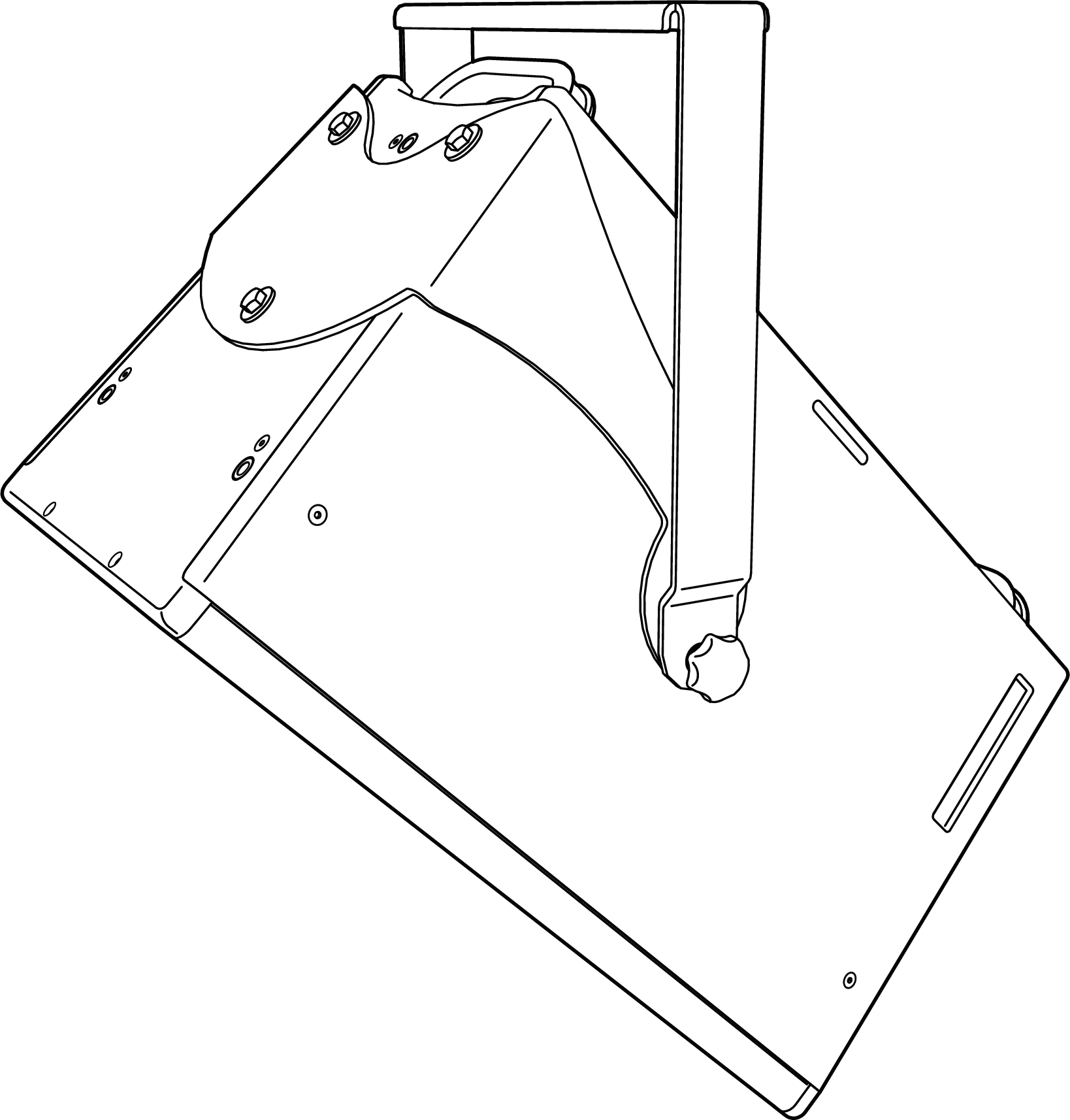
ULTRA-X40 in the MYA-X40 Yoke Mount
Note
The top bar of the MYA-X40 mounting yoke accommodates hanging clamps with standard 1/2-inch or 12 mm bolts.
Caution
THE MYA-X40 Yoke is rated for a single loudspeaker. Never hang a second loudspeaker or other object underneath.
In addition, the yoke may be mounted onto a 35 mm pole using the optional MSA-STAND Adapter Cup 35MM (PN 40.086.013.01) to facilitate easy panning and tilting.

40: ULTRA-X40 in the MYA-X40 Yoke Mount on Pole using the optional MSA-STAND Adapter Cup 35MM

Optional MSA-STAND Adapter Cup 35MM
MUB-X40 U-bracket
THE MUB-X40 U-BRACKET
The MUB-X40 U-Bracket (PN 40.287.055.01) allows a single ULTRA-X40/42 loudspeaker to be mounted to a wall in either vertical or horizontal orientations to the ceiling, onto the floor, or on top of a pole. Mounting the MUB-X40 U-Bracket onto a pole requires a pole mount adapter, such as the 35MM pole stand adapter or the MSA-STAND adapter cup. The MUB-X40 kit includes two M8 bolts, two M8 knobs, and a 35 mm diameter, M20 to M8 thread size reducer. The bolts are recommended for fixed installations.

MUB-X40 U-Bracket (left) with Thread Reducer M20 to M8 (35MM) (right)
The reducer is needed to convert the cabinet's bottom built-in pole mount M20 internal threads to M8 size to install the MUB-X40. The Thread Reducer M20 to M8 35MM can be installed and removed without the need of tools, and it can be conveniently transported on the M8 stud located on one side of the MUB-X40. The thread reducer is also available separately (PN 40.010.540.01).

Converting ULTRA-X40/42 Cabinet to M8 size with Thread Reducer M20 to M8 (35 MM).
MUB-X40 U-Bracket Load Ratings
One ULTRA-X40/42 can be safely mounted with the MUB-X40 U-Bracket at a 5:1 safety factor.
When mounting an ULTRA-X40/42 with the MUB-X40 U-Bracket, the U-Bracket must be secured to the mounting surface with one of the configurations shown in [→ _bookmark72]Table 6 (for hole locations, see [→ _bookmark73]Figure 44 on page 36.
Hole | Safety Factor |
|---|---|
1/2-inch center hole | 5:1 |
Two 1/2-inch outer holes | 5:1 |
All four 1/4-inch corner holes | 5:1 |
Two 1/4-inch center holes | Not rated for mounting. These holes are for pole-mounting the MUB-X40 using a pole-mount adapter. |

MUB-X40 Mounting Hole Configuration Locations

MUB-X40 Wall Mount, Horizontal
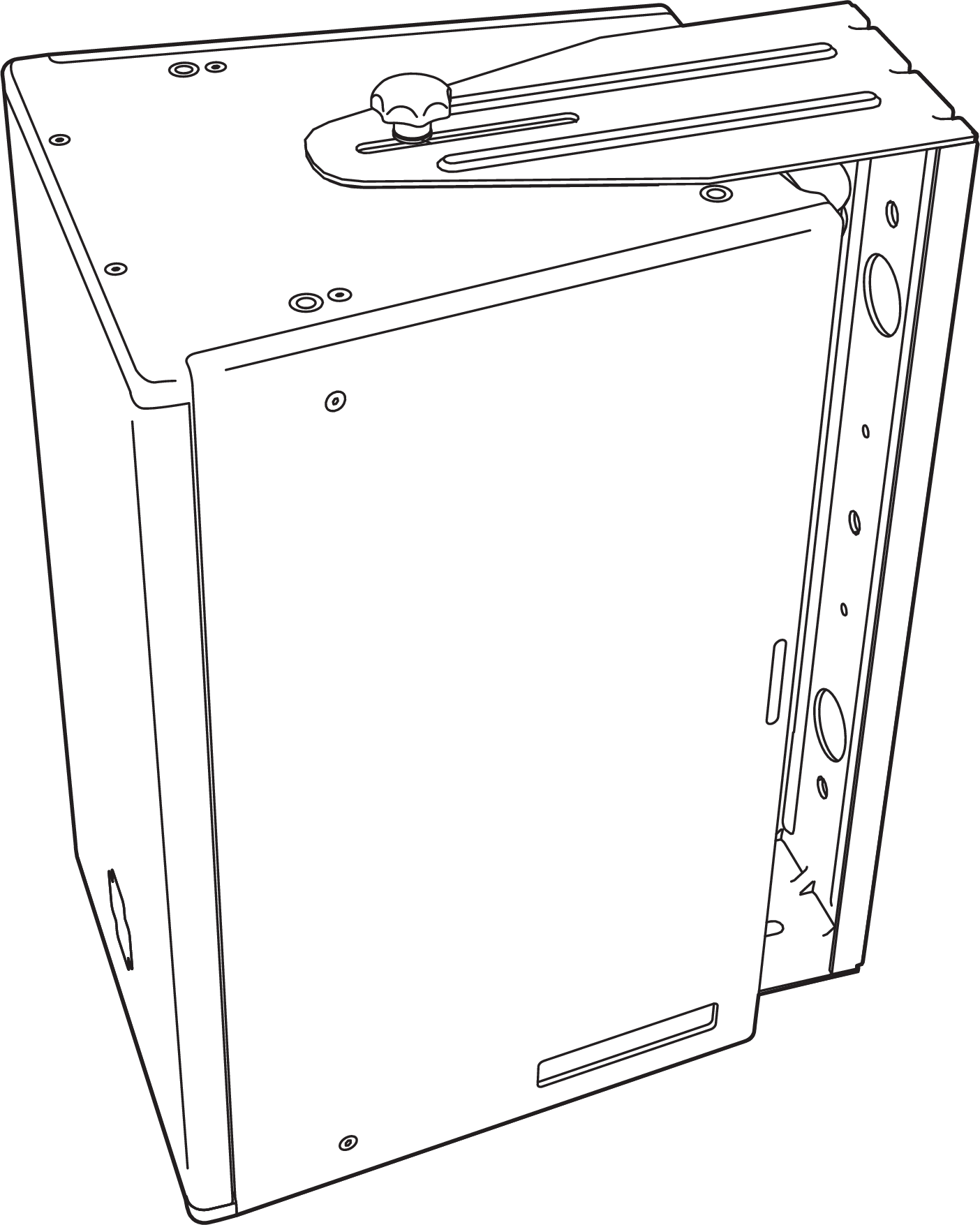
MUB-X40 Wall Mount, Vertical

MUB-X40 Ceiling Mount
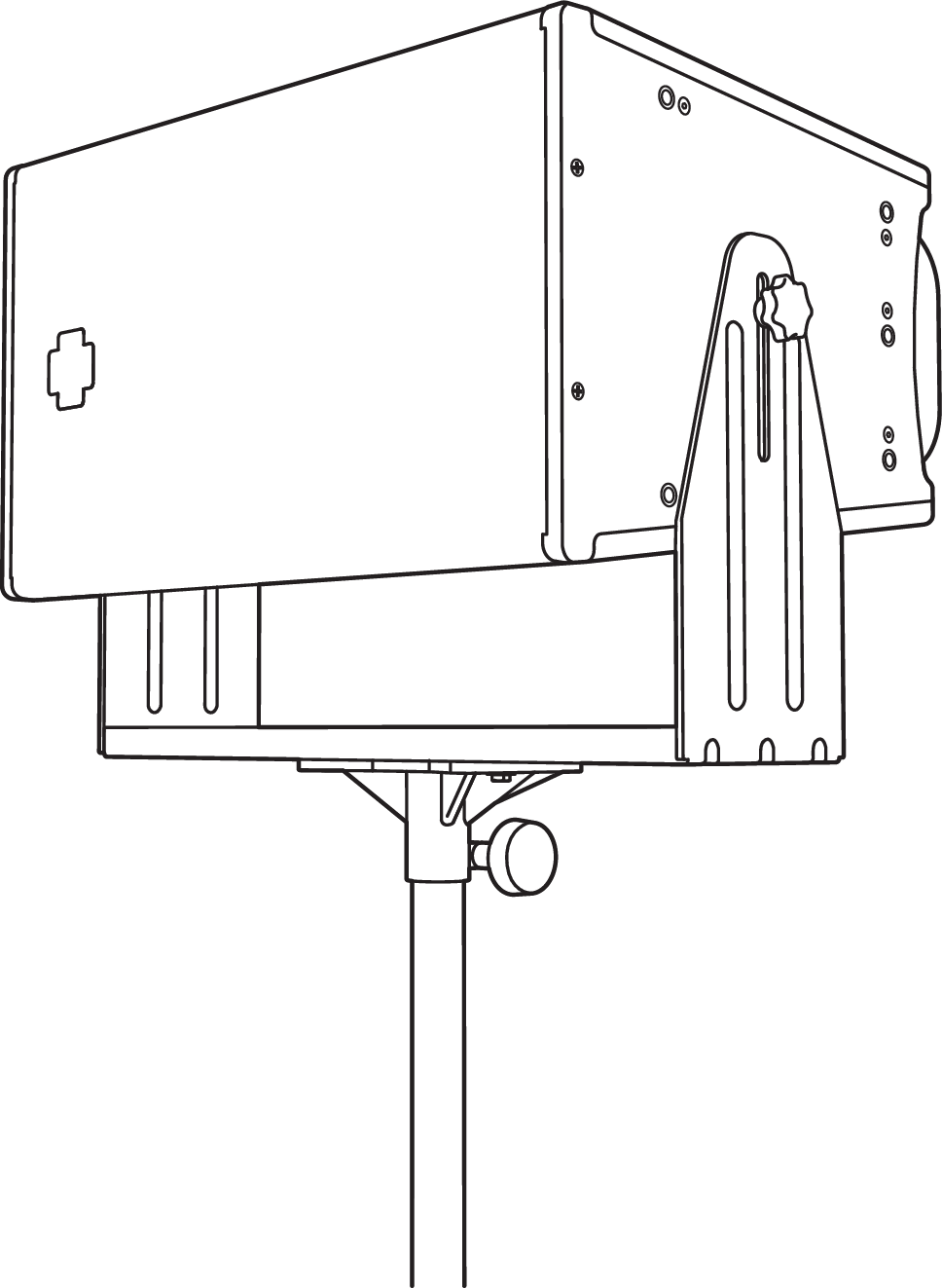
MUB-X40 Pole Mounted using the 35MM Pole Stand Adapter

35MM Pole Stand Adapter
MTC-X40 Top Channel Kit
The MTC-X40 Top Channel kit (PN 40.287.130.01) includes a pinnable link in a channel that mounts directly to the ULTRA-X40/42 rig nuts or into an MCP plate. It supports pick-up of up to three ULTRA-X40/42 loudspeakers from a single point using the two included lock pins and 3/8-inch black shackle. The MTC-X40 Top Channel attaches to the speaker or to an MCP50-X40 or MCP70-X40 plate with two M8 bolts.

MTC-X40 Top Channel Kit Installed at Top of Cab
The versatile configuration of the channel and link, with the ability to slide the pinnable link within the channel, facilitates 9 different top pickup points. This flexibility allows for approximately +10° to –30° tilting of a loudspeaker that hangs from a single point.
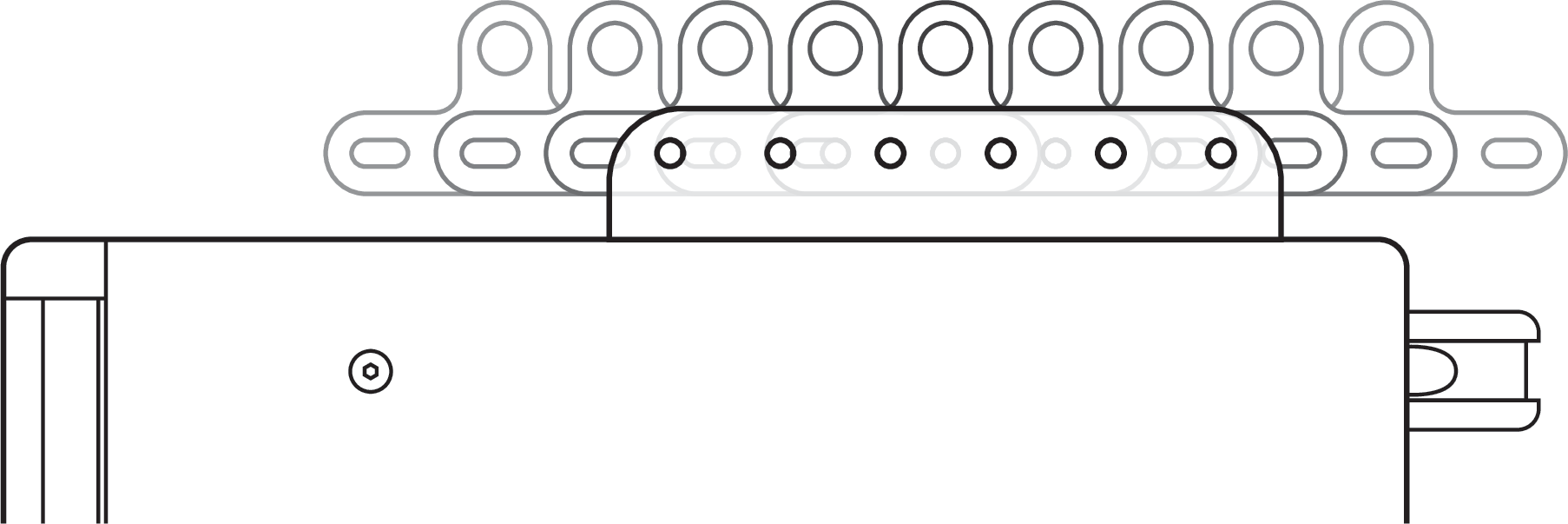
MTC-X40 Pickup Points
Using multiple versions of this kit (together with the Thread Reducer M20 to M8 35MM part sold separately) allows the user to create two- and three-loudspeaker angled configurations.
Note
Using multiple MTC-X40 Top Channel Links in a multi-loudspeaker configuration requires the use of the Thread Reducer M20 to M8 35MM on the bottom of each loudspeaker to which an MTC-X40 will attach.

Attaching MTC-X40 to Bottom
In the example figure below, one Thread Reducer M20 to M8 35MM is required for the upper loudspeaker cabinet.

Example of two MTC-X40 Top Channels linking speakers at a 33° angle with a third MTC-X40 channel on top for pickup point.
Caution
A three-loudspeaker cluster using multiple MTC-X40 Top Channel Links requires the use of a pullback cable attached to an MTC-X40 Top Channel Link that is secured to the bottom of the lowest loudspeaker, as shown in the figure below.
Note
In the figure below, three Thread Reducer M20 to M8 35MM parts are required—one for each loudspeaker cabinet bottom.

Three-ULTRA-X40/42 Cluster using MTC-X40s requires pullback cable
Channel and Link Splay Angles | |
|---|---|
 |  |
 |  |
 |  |
 |  |
MCP50-X40 and MCP70-X40 Cluster Plates
Meyer Sound offers two cluster plate versions: the MCP50-X40 Cluster Plate (PN 40.287.100.01), which when used in pairs, facilitates installation of up to three ULTRA-X40/42 loudspeakers in both horizontal and vertical clusters at variable splay angles between 10° and 50° in 5° increments, and the MCP70-X40 Cluster Plate (PN 40.287.400.01) that supports splay angles between 40° and 70°, also in 5° degree increments.

MCP70-X40 Cluster Plate (M8 knobs in transport positions)

MCP70-X40 Cluster Plate (M8 knobs in transport positions)
These kits include four M8 bolts and four M8 knobs. The bolts are recommended for fixed installations, while the knobs are for portable applications. The MCP plates include four threaded positions to hold the M8 knobs during transport.
Using these cluster plates, along with the MTC-X40 Top Channel, or the MTB-X40 Top Bracket (see MTB-X40 Top Bracket, users have the ability to create horizontal and vertical two and three-speaker clusters.
Even splay angles are obtained by using symmetric holes on either side; odd splay angles use a wider position hole on one side of the cluster plate. See Table 8 for examples.
Caution
When making horizontal clusters, always use two plates—one on top and one on bottom—to splay two adjacent loudspeakers (two plates for two-loudspeaker clusters, four plates for three-loudspeaker clusters).
Note
Optimal acoustical performance for an ULTRA-X40/42 array is achieved by using an adequate number of units as well as selecting the specific angles between cabinets to fill the requirements of the application. In general, larger angles can create a hole in the coverage and smaller angles can cause too much interaction.
Tip
The MAPP System Design Tool, covered in greater detail in Chapter 7, is the method of choice to enable you to make accurate and comprehensive predictions for optimal coverage during the design phase.

MCP50-X40 Cluster Plate shown in a 50° horizontal splay angle, two-loudspeaker cluster with MTC-X40 Top Channel on top

MCP70-X40 Cluster Plate shown in a 70° horizontal splay angle, two-loudspeaker cluster with MTC-X40 Top Channel on top
The table below provides illustrations of the type of splay angle configurations possible with two- and three-loudspeaker, horizontal and vertical configurations.
Tip
Use MAPP to accurately predict the interaction of loudspeakers at different angles to ensure appropriate loudspeaker deployment and subwoofer integration. For more information, see MAPP System Design Tool.

Four MCP50-x40 Cluster Plates shown set to 50° horizontal splay angles with MTC-X40 Top Channel for pick up point on center loudspeaker
MCP50-X40 Cluster Plate Examples | MCP70-X40 Cluster Plate Examples |
|---|---|
 |  |
 |  |
 |  |
 |  |
 |  |
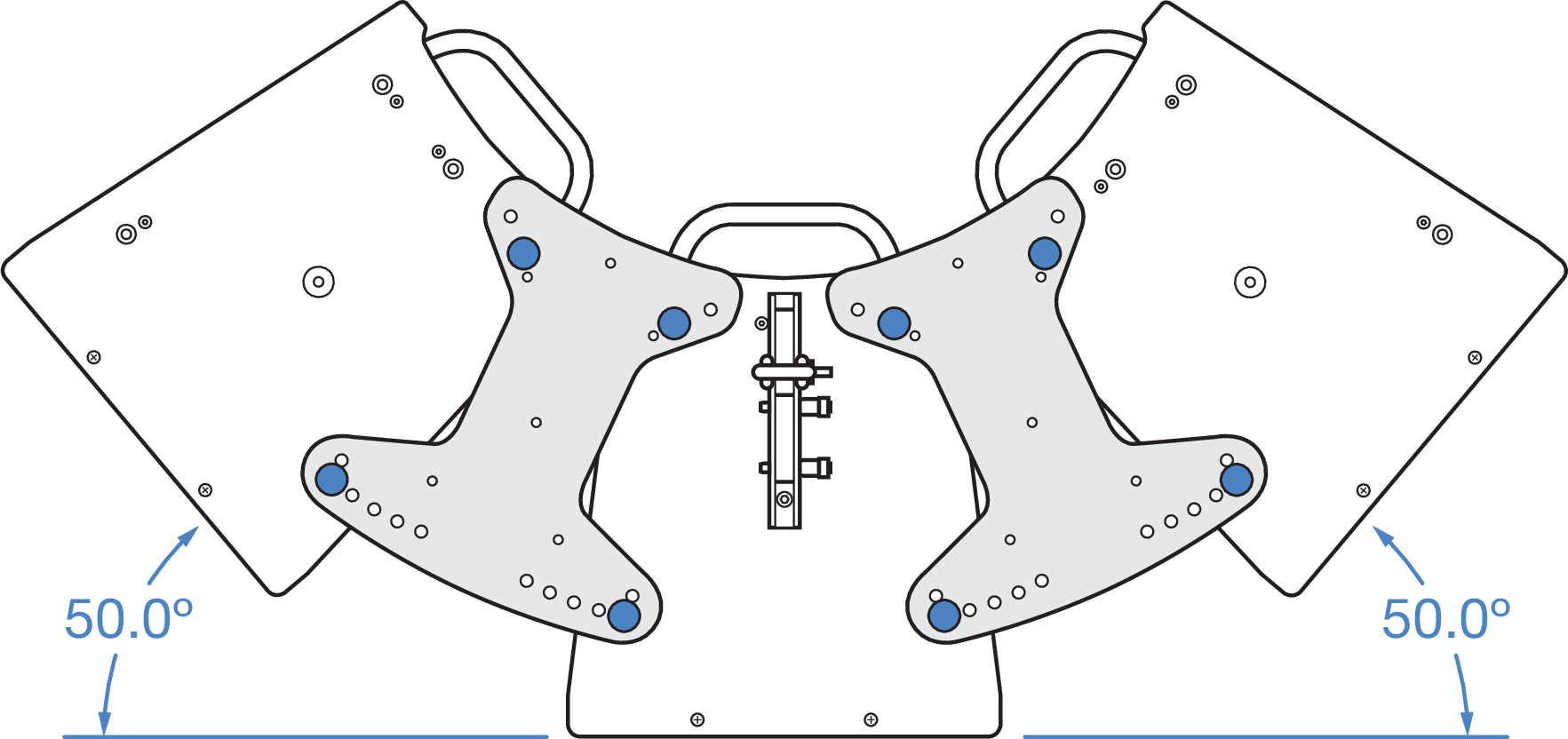 |  |
MTB-X40 Top Bracket
The MTB-X40 Top Bracket (PN 40.287.150.01) is a heavy duty, U-bracket style accessory that facilitates mounting of up to three ULTRA-X40/42 loudspeakers from a ceiling or truss. The kit includes four M8 bolts, and four M8 knobs.

MTB-X40 Top Bracket
The bolts are recommended for fixed installations, while the knobs are for portable applications.
The design supports from 5° to 25° of downtilt in 5° increments (Figure 61). It supports 5° of uptilt (Figure 63). It also enables mounting of a single ULTRA-X40/42 onto the floor for front-fills.

MTB-X40 Top Bracket set at 25° downtilt

MTB-X40 Top Bracket set at 0°
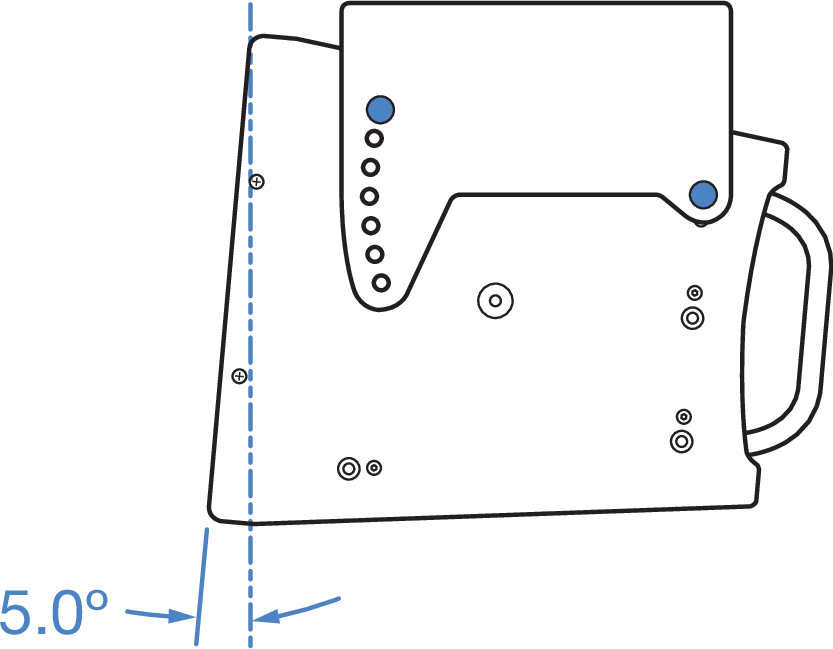
MTB-X40 Top Bracket set at 5° uptilt
The sturdy MTB-X40 Top Bracket can support up to three ULTRA-X40/42 loudspeakers in a vertical cluster (Figure 64 and Figure 65) when used in conjunction with either of the MCP50-X40 or the MCP70-X40 Cluster Plates. Two plates (one kit) are required for two-speaker clusters. Four plates (two kits) are required for three-speaker clusters.

MCP50-X40 Cluster Plate creates a 50° vertical splay angle cluster with the MTB-X40 Top Bracket on top set at 10° angle

MCP70-X40 Cluster Plate creates a 70° vertical splay angle cluster with the MTB-X40 Top Bracket on top set at 10° angle
Caution
When making vertical clusters, always use two plates—one on the left and one on the right—to splay two adjacent loudspeakers (two plates for two-loudspeaker clusters, four plates for three-loudspeaker clusters).
The splay angles created by the cluster plate configurations as illustrated in Table 8 apply to vertical clusters as well. Figure 66, Figure 67 and Figure 68 provide representative drawings in the vertical orientation to illustrate.

MCP50-X40 Cluster Plate in 10° vertical splay angle

MCP50-X40 Cluster Plate in 15° vertical splay angle

MCP50-X40 Cluster Plate in 50° vertical splay angle
Caution
When mounting the MTB-X40 from the Center hole (Figure 69), a maximum of two loudspeakers maybe clustered.
When making three-loudspeaker vertical clusters using the MTB-X40, the MTB-X40 must always be horizontal (0°) with respect to the floor.
For three-loudspeaker clusters, there are BGV-C1 limitations on the maximum angles between the MTB-X40 and the first loudspeaker, and on the angles between the first/second and second/third loudspeakers. See Figure 69, Figure 70, Table 9 and Table 10.

MTB-X40 (top side) mounting hole options

Three-ULTRA-X40 vertical cluster angles
A | B | C |
|---|---|---|
+5° | -10° to -35° | No restrictions |
-40° | -10° to -55° | |
-45° | -10° to -40° | |
-50° to -70° | 3rd loudspeaker not allowed | |
0° | -10° to -25° | No restrictions |
-30° | -10° to -60° | |
-35° | -10° to -35° | |
-40° to -70° | 3rd loudspeaker not allowed | |
-5° | -10° to -15° | No restrictions |
-20° | -10° to -60° | |
-25° | -10° to -40° | |
-30° | -10° to -30° | |
-35° to -70° | 3rd loudspeaker not allowed | |
-10° to -25° | All angles | 3rd loudspeaker not allowed |
A | B | C |
|---|---|---|
+5° | All angles | No restrictions |
0° | All angles | No restrictions |
-5° | -10° to -55° | No restrictions |
-60° | -10° to -45° | |
-65° | -10° to -35° | |
-70° | 3rd loudspeaker not allowed | |
-10° | -10° to -45° | No restrictions |
-50° | -10° to -45° | |
-55° | -10° to -35° | |
-60° to -70° | 3rd loudspeaker not allowed | |
-15° | -10° to -30° | No restrictions |
-35° | -10° to -65° | |
-40° | -10° to -45° | |
-45° | -10° to -30° | |
-50° to -70° | 3rd loudspeaker not allowed | |
-20° | -10° to -20° | No restrictions |
-25° | -10° to -65° | |
-30° | -10° to -45° | |
-35° to -70° | 3rd loudspeaker not allowed | |
-25° | All angles | 3rd loudspeaker not allowed |
Note
Optimal acoustical performance for an ULTRA-X40/42 array is achieved by using the adequate number of units as well as selecting the specific angles between cabinets to fill the require- ments of the application. In general, larger angles can create a hole in the coverage and smaller angles can cause too much interaction.
Tip
The MAPP System Design Tool, covered in greater detail in [→ _bookmark108]Chapter 7, is the method of choice to enable you to make accurate and comprehensive predictions for optimal coverage during the design phase.
System Design and Integration Tools
MAPP System Design Tool
The MAPP System Design Tool is a powerful, cross-platform application for accurately predicting the coverage pattern, frequency response, phase response, impulse response, and SPL capability of individual or arrayed Meyer Sound loudspeakers.

MAPP System Design Tool
Whether planning for fixed installations or for tours with multiple venues, use MAPP to accurately predict the appropriate loudspeaker deployment for each job, complete with coverage data, system delay and equalization settings, rigging information, and detailed design illustrations. MAPP’s accurate, high-resolution predictions ensure that systems will perform as intended, thereby eliminating unexpected coverage problems and minimizing onsite adjustments.
The key to the accuracy of MAPP’s predictions is MeyerSound’s exhaustive database of loudspeaker measurements. Performance predictions for each loudspeaker are based on 3-dimensional, 65,000+ 1/48th-octave-band measurements taken in the MeyerSound anechoic chamber. The extraordinary consistency between Meyer Sound loudspeakers guarantees that predictions from MAPP will closely match their actual performance.
MAPP software allows for configuration of MeyerSound loudspeaker systems and definition of the environment in which they operate, including air temperature, pressure, humidity, and the location of prediction surfaces. Importing both CAD (.DXF) and Sketchup (.SKP) files containing detailed venue information to act as an anchor model to the prediction surfaces and a visual aid to facilitate prediction data interpretation is also possible.
Tip
See meyersound.com for support and more information about MAPP.
MAPP Capabilities
With MAPP, you can:
Simulate different loudspeaker configurations to refine system designs and determine the best coverage for intended audience areas
Model loudspeaker interactions to locate constructive and destructive interferences so that loudspeakers can be re-aimed and repositioned as necessary
Place microphones anywhere in the Model View space and predict loudspeaker frequency response, phase response, and sound pressure levels at each microphone position
Determine delay settings for fill loudspeakers using the Inverse Fast Fourier Transform and phase response feature
Preview the results of signal processing to determine optimum settings for the best system response
Automatically calculate load information for arrays to determine necessary minimum rigging capacity, front-to-back weight distribution, and center of gravity location
Generate and export system images and system PDF reports for client presentations
Synchronize GALAXY processor output channel settings in real-time with virtual or real GALAXY units, allowing in-the-field changes to be predicted during system alignments
Galileo GALAXY Network Platform
The Galileo GALAXY Network Platform is a sophisticated loudspeaker management tool for controlling all MeyerSound speaker types. The GALAXY loudspeaker processor extends a high level of audio control in driving and aligning loudspeaker systems with multiple zones. It provides a powerful tool set for corrective equalization (EQ) and creative fine-tuning for a full range of applications from touring to cinema.
Users can readily program the GALAXY processor using Compass software running on a host computer or via the Compass Go application for the iPad. Connecting MAPP to the GALAXY processor will also allow the user to push output channel settings created in MAPP as a starting point. Compass Control Software includes custom-designed settings for each family of speakers, as well as to integrate families together. For example, the Product Integration feature matches the phase characteristics between Meyer speaker families to ensure the most coherent summation.
Processing tools for inputs and outputs include delay, parametric EQ and U-Shaping EQ. Output processing also includes polarity reversal, Low-Mid Beam Control (LMBC), atmospheric correction, and All Pass filters.
The built-in summing and delay matrices allow a user to easily assign gain and delay values, respectively, at each cross point. This capability greatly facilitates using one loudspeaker to satisfy multiple purposes.
Front panel controls let a user intuitively and quickly operate a GALAXY processor without a computer during live use.
The GALAXY 408, GALAXY 816 and GALAXY 816-AES3 processor versions have the same audio processing capability with different I/O. See www.meyersound.com to locate their datasheets for more information.
Meyer Sound Weather Protection
The Weather Protection option from Meyer Sound is intended to increase the useful life of Meyer Sound loudspeakers when they are installed outdoors and exposed to different and often harsh weather conditions. Our Weather Protection includes a penetrating treatment to raw wood, use of special primers, and plating on all steel parts used (or alternatively, the use of stainless steel hardware). Weather Protection is designed to prevent malfunctions caused by harsh operating environments and slows the accelerated wear and tear that occurs in outdoor environments.
When Is Weather Protection Advisable?
Weather Protection is strongly recommended for all permanent outdoor installations where loudspeakers are directly exposed to the elements. This includes desert and semi-arid climates, where protection against dust and sand is important, and where infrequent rainstorms can contribute to deterioration of loudspeaker components.
Weather Protection is also recommended when the loudspeakers are sheltered from direct exposure to precipitation but are nevertheless exposed to prolonged high humidity, fog or mist. Examples would be installations on covered outdoor terraces or pavilions
Weather Protection is further advisable for portable or touring systems when any significant outdoor use is anticipated. Even though standard procedures may call for using external protective measures, these are often not implemented in time to prevent moisture intrusions that could lead to premature performance degradation of the loudspeaker.
Climate Variation and Owner Maintenance
The wear and tear on a loudspeaker will vary significantly with different climatic conditions. For example, a weather protected loudspeaker installed in a sunlight-exposed location on an ocean pier will experience much harsher conditions than a loudspeaker in a similar installation that is shaded by trees and exposed only to rainfall. The constant exposure to direct UV radiation and salt air environment will cause a loudspeaker to wear more quickly than one with partial UV shielding and exposed only to freshwater moisture.
Wear can eventually affect the performance of the loudspeaker. It also affects aesthetics. For example, in salt air environments, the exterior grille can quickly show signs of oxidation, causing unsightly discoloration.
Apart from selecting suitable weather protection, the progress of wear and tear on the loudspeaker can be slowed by a regular schedule of inspection and cleaning. This maintenance is particularly necessary in harsh environments. Inspection and cleaning should include routine removal of any visible oxidation or environmental particulates, as these can accelerate metal corrosion or decay of the cabinet. If installed loudspeakers are not in use for an extended period, exterior protection or temporary removal and storage of the loudspeakers should be considered.
Benefits of Weather Protection
There are several benefits to selecting the Meyer Sound Weather Protection option:
Functionality - Weather Protection prolongs the service life of the loudspeaker by preventing premature degradation of internal components.
Safety - Weather Protection lessens the chance of electrical malfunctions or structural failures.
Warning
IT IS THE RESPONSIBILITY OF PURCHASERS/USERS/OPERATORS TO SELECT WEATHER PROTECTION WHEN APPROPRIATE FOR THEIR USE AND TO PERIODICALLY INSPECT THEIR LOUDSPEAKER INSTALLATIONS FOR ANY DETERIORATION THAT MAY LEAD TO SAFETY CONCERNS.
Aesthetics - Weather Protection slows wear and tear on the exterior of the loudspeaker in harsh conditions. Early signs of wear and tear on the exterior of the loudspeaker indicate over-exposure to the elements.
Standards Compliance - Weather Protection helps in meeting IP ratings for loudspeakers. IP ratings are an internationally recognized standard often used in installations involving our products. A further explanation of IP ratings is given in the IP Ratings.
Weather Protection Components
Standard Weather Protection
Meyer Sound designs toward an IP rating of IPX4 (see IP Ratings) for Standard Weather Protection, which includes the following components:
Wood treatment — Prior to cabinet manufacturing, the raw wood receives a special treatment that penetrates and stabilizes the wood fibers to withstand a wide range of temperatures and exposure to extreme humidity.
Cabinet finishing — The assembled cabinets receive a highly impervious finish that includes a sealing primer and a finishing topcoat. The coatings are applied on both surfaces, with one coat on the interior and two on the exterior. The final step is a two-part modified acrylic urethane similar to that used in military applications.
Driver treatment — All cone drivers are coated with a water-resistant sealant.
Exterior protection — Grille frames are coated to resist corrosion, and all components that mount to the cabinet use custom gaskets and stainless steel fasteners.
Removable rain hood — The rain hood is designed to shield connectors even in wind-driven rain.
Installation Practices
Meyer Sound assumes normal and accepted installation practices are used when installing Meyer Sound Loudspeakers outdoors. Deviation from such practices may cause weather protection to be ineffective and void the warranty for the loudspeaker.
Examples of unacceptable and acceptable installation practices include:
Loudspeakers installed outdoors should not face upward.
Loudspeakers with a rain hood should be installed in such a way that the rain hood opening is not facing any direction but down.
Meyer Sound-supplied rigging components should not be modified (for example, by drilling additional holes in a MUB for mounting to a wall). When an installer/integrator modifies a Meyer Sound-supplied rigging component to support their installation method, it is considered compromised and out of warranty.
All loudspeaker cabling must be installed with a "drip-loop" or equivalent method to ensure that rain/ water is NOT wicked toward the loudspeaker.
If in doubt about an installation method, contact Meyer Sound Technical Support for assistance.
Always discuss the environmental conditions of your Meyer Sound installation with your Sales Manager, and verify the availability of Weather Protection for your selected loudspeaker models. The Sales Manager, together with Technical Support, will verify the appropriate level of weather protection for the loudspeakers and related rigging hardware.
IP Ratings
IP stands for "Ingress Protection." The current format for expressing an IP rating is a 2-digit code. The first digit of an IP rating represents protection from solid objects. The second digit of an IP rating represents protection from water or moisture. The table below provides a chart of IP ratings and the corresponding definitions of the rating.
Note
IP ratings only apply to the "ENCLOSURE." A loudspeaker is considered an enclosure and as such we can apply an IP rating to it. Rigging hardware is not an enclosure and therefore IP ratings do not apply. Also, cable and cable-mount connectors used to connect to the loudspeaker are NOT part of the enclosure and therefore not part of the IP rating. Only the chassis-mounted part of the connector is considered part of the enclosure.
First Digit (Protection against solid objects) | Definition | Second Digit (Protection against liquids) | Definition |
|---|---|---|---|
X | Characteristic numeral is not required to be specified. | X | Characteristic numeral is not required to be specified. |
0 | No protection | 0 | No protection |
1 | Protected against solid objects over 50mm. | 1 | Protected against vertically falling drops of water. |
2 | Protected against solid objects over 12 mm. | 2 | Protected against direct sprays up to 15° from the vertical. |
3 | Protected against solid objects over 2.5mm. | 3 | Protected against direct sprays up to 60° from the vertical |
4 | Protected against solid objects over 1 mm. | 4 | Protected against direct sprays from all directions. Limited ingress permitted |
5 | Protected against dust. Limited ingress permitted. | 5 | Protected against low-pressure jets of water from all directions. Limited ingress permitted. |
6 | Totally protected against dust. | 6 | Protected against strong jets of water from all directions. Limited ingress permitted. |
7 | Protected against the effect of temporary immersion between 15cm and 1m. | ||
8 | Protected against the effect of long-term submersion of 1m or more. |
Rain Hoods
Weather-protected ULTRA-X40/42 loudspeakers include a rain hood for indoor/outdoor touring and sheltered outdoor installations. Meyer Sound offers two rain hood models: A fixed rigid rain hood for permanent installations and a collapsible hood for portable applications. Please specify your rain hood when placing the order.
Rigid Rain Hood
The ULTRA-X40/42 rigid removable rain hood is easily attached and removed with the included four screws, as shown in the figure below.
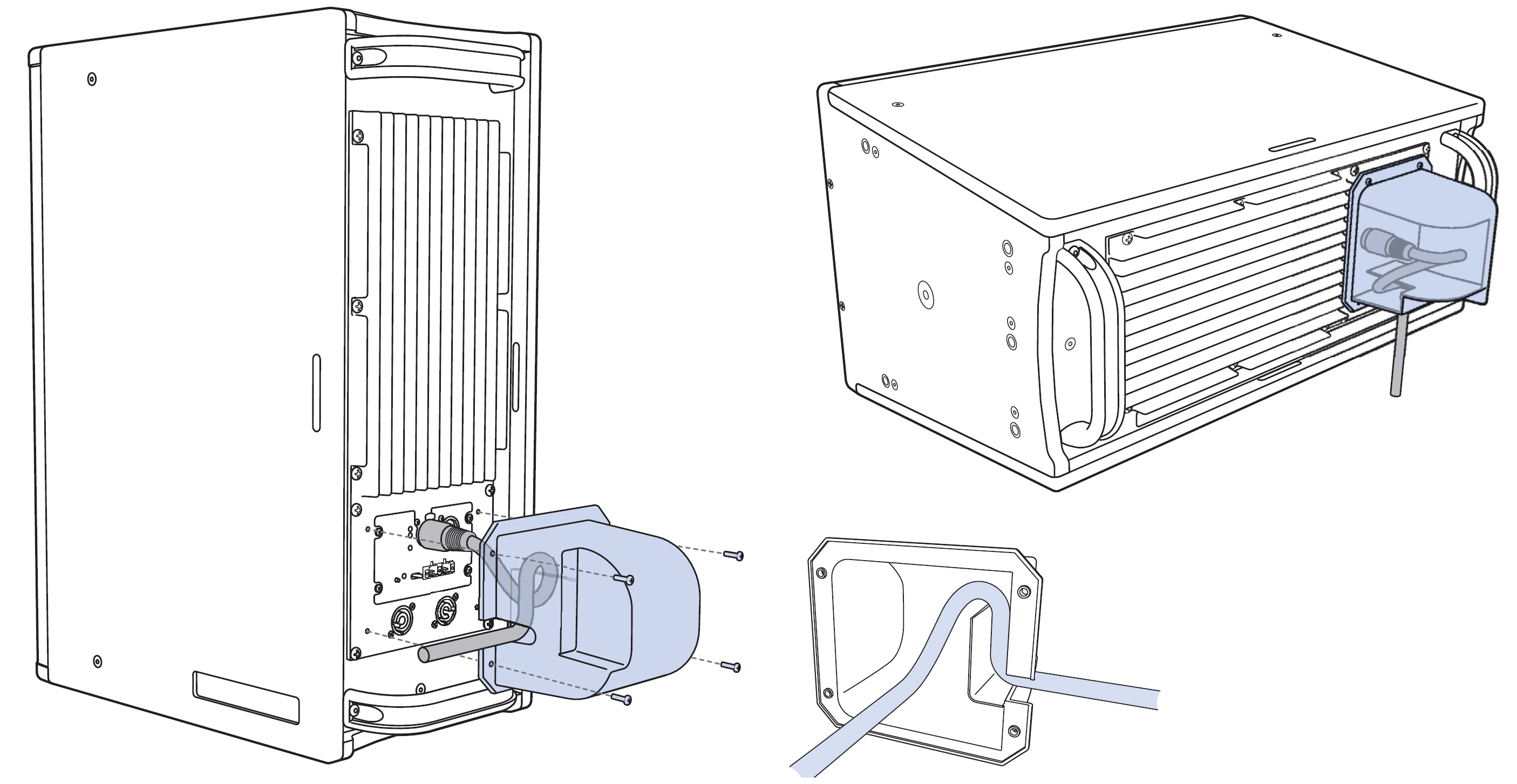
ULTRA-X40/42 with Rigid Rain Hood in Proper Vertical Orientation (left), Proper Horizontal Orientation (top right) and Correct Interior Cable Routing Illustration (bottom right)
Attach any required cables to the ULTRA-X40/42 loudspeaker.
Carefully route the cables, so that they wrap over and down the inner rain hood wall.
Attach the rain hood to the user panel, and secure it to the center of the panel with its four 6-32 screws.
Make sure to tighten the screws to create a good seal against the user panel. The recommended torque value for the screws is 10–12 in-lb (1.1–1.4 N-m).
Caution
There is only one proper vertical loudspeaker orientation and one proper horizontal loudspeaker orientation when the rain hood is installed.
The weather-protected ULTRA-X40/42 must be mounted with a 0° tilt, or preferably with a slight down-tilt. This angle shields the driver from the elements and does not allow water to accumulate. Do not tilt the cabinet up, as the drivers and cabinet will accumulate water.
Note
Weather-protected units using the rigid rain hood are rated IPX4 for water intrusion.
Collapsible Rain Hood
The ULTRA-X40/42 collapsible rain hood is installed on the unit when shipped. Four screws secure its frame permanently into place, as shown in the figure below. When using the rain hood, the loudspeaker has only one possible vertical and one possible horizontal position, as all cables must exit from the lower end of the loudspeaker.

ULTRA-X40/42 with collapsible rain hood in vertical (left) and horizontal (right) orientations
Detach the Velcro straps and extend the rain hood.
Lift the front flap.
Attach any required cables to the ULTRA-X40/42. (The clear windows let you easily locate the connectors on the user panel.)
Secure the cable protector with the Velcro attachments.
Secure the front flap Velcro edges.
To stow the rain hood, reverse the steps.
Although not recommended, if for any reason the rain hood is removed, make sure to tighten the screws when reinstalling to create a good seal against the user panel. The recommended torque value for the screws is 10–12 in-lb (1.1–1.4 N-m).
Caution
The weather-protected ULTRA-X40/42 must be mounted with a 0° tilt, or preferably with a slight down-tilt. This angle shields the driver from the elements and does not allow water to accumulate. Do not tilt the cabinet up, as the drivers and cabinet will accumulate water.
The ULTRA-X40/42 must be oriented so that the cord exits at the bottom of the rain hood. Use care when installing the loudspeaker to ensure the rain hood is positioned to work properly when unfolded.
Note
Weather-protected units using the collapsible rain hood are intended for portable uses and temporary outdoor deployment. The rain hood is designed to protect the connectors from direct exposure to rain.
ULTRA-X40 Loudspeaker Dimensions

ULTRA-X42 Loudspeaker Dimensions
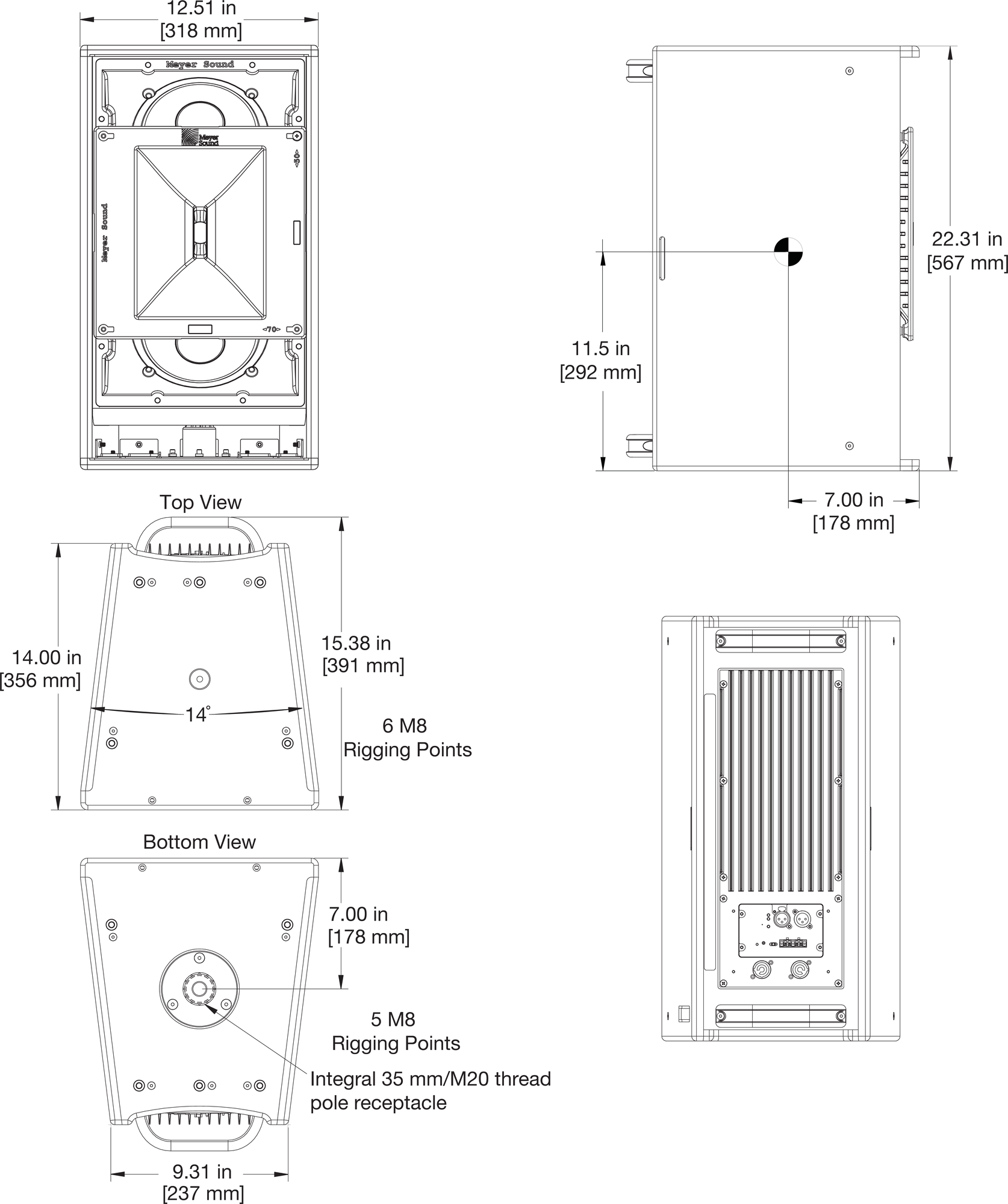
ULTRA-X40|42 with Rain Hood Loudspeaker Dimensions

MTB-X40 Dimensions

MUB-X40 Dimensions
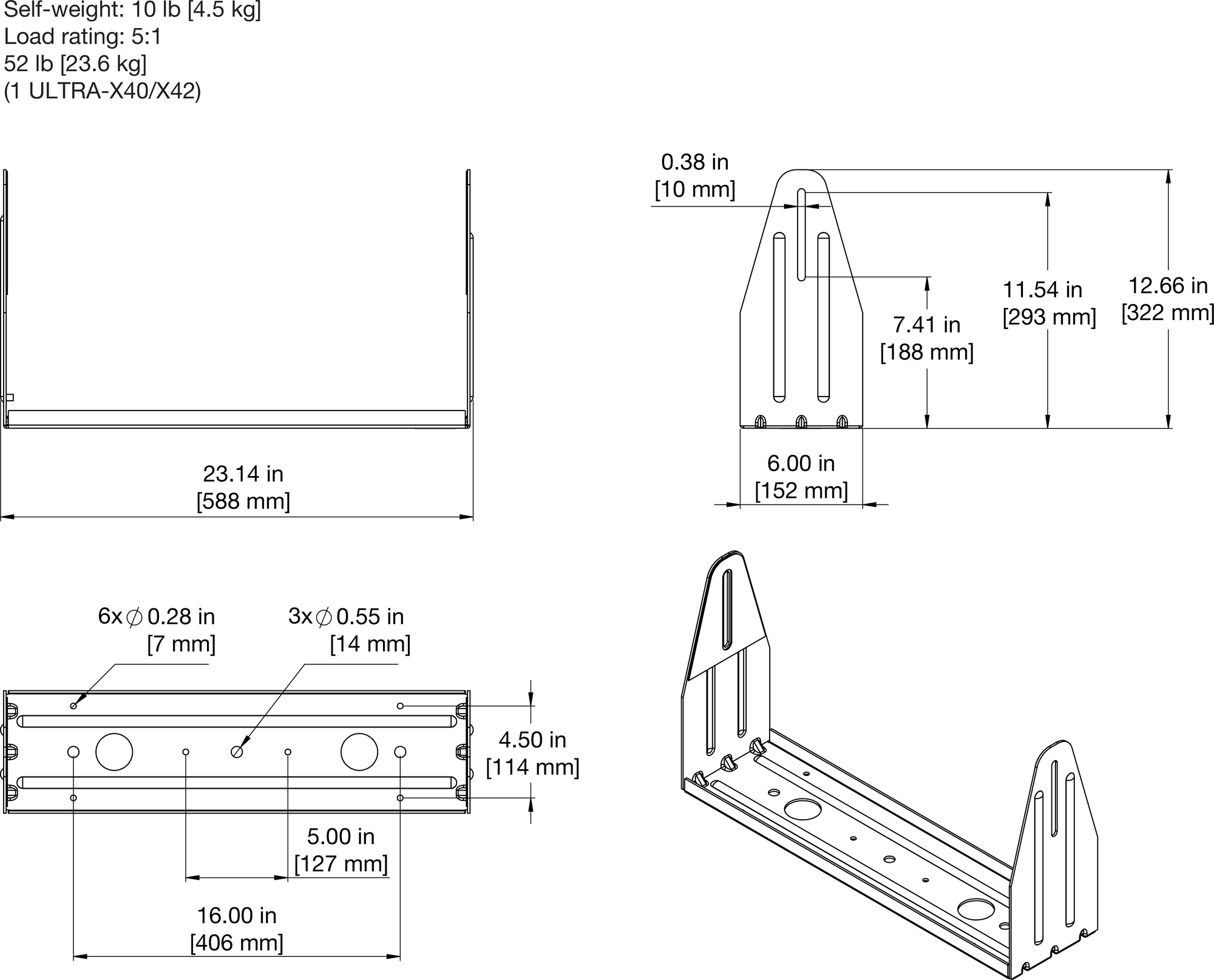
MYA-X40 Dimensions

MTC-X40 Dimensions

